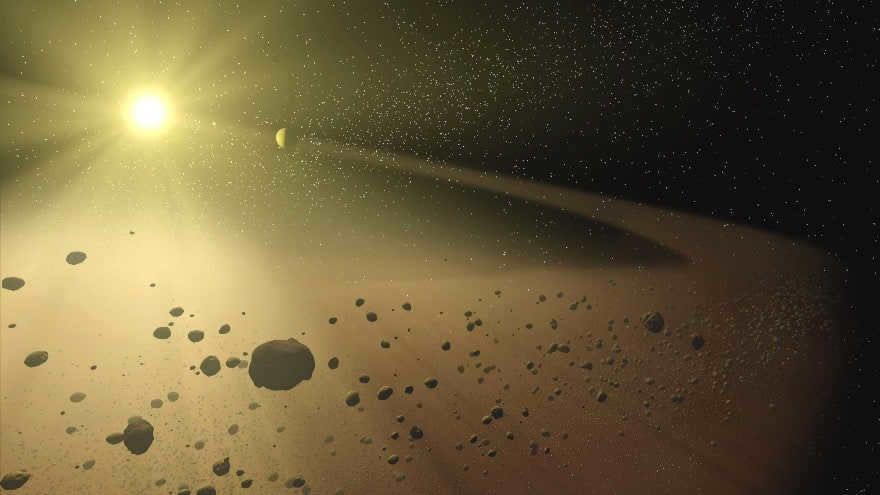
The Kuiper Belt and the Oort Cloud – regions in the solar system: their location, description, and characteristics along with images, intriguing information, scientific research, discovery, and celestial bodies.
The Kuiper Belt – A vast collection of icy objects situated at the outermost region of our solar system. The Oort Cloud – A spherical structure that houses comets and other celestial bodies.
Following the discovery of Pluto in 1930, scientists began to speculate that it might not be the farthest object in the system. With time, they observed the movements of other objects and identified a new region in 1992. Now, let’s explore some fascinating details about the Kuiper Belt.
Interesting facts about the Kuiper Belt
- The Kuiper Belt has the capacity to hold hundreds of thousands of icy objects ranging in size from small fragments to objects as large as 100 kilometers;
- A majority of the short-period comets originate from the Kuiper Belt, with their orbital period not exceeding 200 years;
- The primary region of the Kuiper Belt likely contains over a trillion comets;
- The largest objects in the Kuiper Belt include Pluto, Quavar, Makemake, Haumea, Ixion, and Varuna;
- In 2015, the first mission to the Kuiper Belt was launched. The New Horizons probe explored Pluto and Charon;
- Belt-like structures have been observed around other stars, such as HD 138664 and HD 53143;
- The ice found in the Kuiper Belt formed during the early stages of the solar system’s creation. It provides insights into the conditions of the early nebula;
What is the Kuiper Belt?
The Kuiper Belt is a region located beyond the orbit of Neptune. Similar to the Asteroid Belt, which is situated between Mars and Jupiter, it contains remnants from the early formation of our solar system. However, the Kuiper Belt is much larger, ranging in size from 20 to 200 times that of the Asteroid Belt. Without the gravitational influence of Neptune, the fragments within the Kuiper Belt would have merged together to potentially form new planets.
The Kuiper Belt: Its Discovery and Naming
The existence of additional celestial entities was initially brought to light by Frekrik Leonard, who referred to them as ultra-Neptunian bodies located beyond Pluto. Subsequently, Armin Leuschner proposed the idea that Pluto might be merely one among numerous long-period planetary objects that have yet to be discovered. Presented below are the most sizable objects within the Kuiper Belt.
The biggest objects in the Kuiper Belt
In 1943, Kenneth Edgeworth released a publication in which he argued that the matter surrounding Neptune was too widely dispersed to coalesce into a larger celestial body. Then, in 1951, Gerard Kuiper joined the conversation, proposing the existence of a disk that emerged during the early stages of the solar system’s evolution. This concept gained widespread acceptance as it provided an explanation for the origin of comets.
Fast forward to 1980, Julio Fernandez determined that the Kuiper Belt extended from 35 to 50 astronomical units (a.u.). Subsequently, computer models based on Fernandez’s calculations revealed that the Oort Cloud alone could not account for all comets, further supporting the plausibility of the Kuiper Belt theory.
In 1987, David Jewett and Jane Lu embarked on an extensive search for celestial objects, utilizing telescopes at the Keith Peake National Observatory and the Cerro Tololo Observatory. Their efforts bore fruit in 1992 when they announced the discovery of 1992 QB1, followed by the identification of 1993 FW six months later.
Many articles initially referred to the hypothetical region as the Kuiper Belt, a name that has since become the official designation.
However, there are dissenting voices who argue that Gerard Kuiper had a different intention and that all recognition should be given to Fernandez. As a result of this controversy, the term “trans-Neptunian objects” is now favored in scientific communities.
The Characteristics of the Kuiper Belt
What is the makeup of the Kuiper Belt? The belt is home to numerous objects, and estimates suggest that there are around 100,000 objects with diameters exceeding 100 kilometers. These objects are thought to be primarily composed of ice, which consists of a blend of light hydrocarbons, ammonia, and water ice.
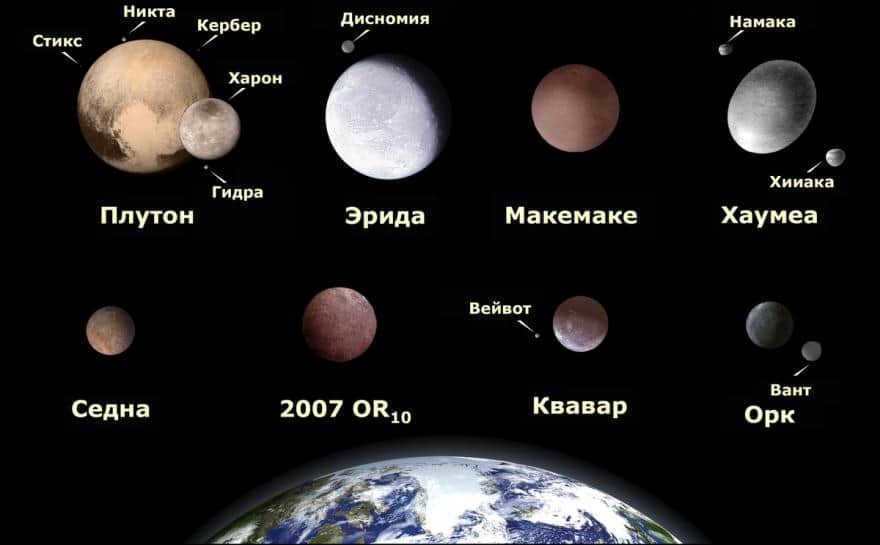
Here is an image depicting the largest objects in the Kuiper Belt.
Water ice has been discovered on certain objects within the Kuiper Belt. In 2005, Michael Brown made the determination that 50000 Kvavara contains water ice and ammonia hydrate. Both of these substances have disappeared over time due to the evolution of the solar system. This suggests that there is either tectonic activity occurring on the object or that a meteorite impact has taken place.
Among the notable celestial bodies within the Kuiper Belt are Kwawar, Makemake, Haumea, Ork, and Eridu. These objects played a role in the reclassification of Pluto as a dwarf planet.
In 2006, the New Horizons spacecraft was launched by NASA to explore Pluto. It successfully reached its destination in 2015 and provided the first close-up images of the dwarf planet, revealing its distinctive “heart” feature. Currently, the spacecraft is venturing into the Kuiper Belt to study the objects within this region.
The Kuiper Belt is a vast area of space that contains a multitude of comets. Despite its size, there is limited knowledge about this region. One of the most well-known comets within the Kuiper Belt is Halley’s Comet, which has a periodicity of approximately 16,000 to 200,000 years.
The Outlook for the Kuiper Belt in the Years Ahead
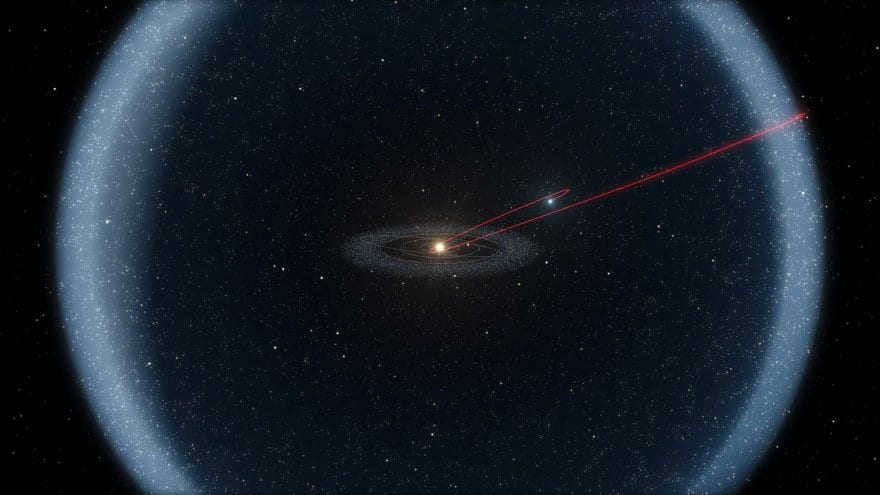
According to Gerard Kuiper, the existence of Trans-Neptunian Objects (TNOs) is not indefinite. The belt spans approximately 45 degrees across the celestial sphere, housing numerous objects that frequently collide and disintegrate into dust. It is speculated that in hundreds of millions of years, the belt will cease to exist. Hopefully, the New Horizons mission will reach it before that happens!
For centuries, humanity has observed the appearance of comets and endeavored to comprehend their origins. If comets’ icy coatings evaporate as they approach a star, it indicates that they must originate from a significant distance away.
Over the years, scientists have reached the conclusion that there exists a vast collection of icy and rocky bodies beyond the orbit of the planets. This collection has been named the Oort Cloud, although it remains a theoretical construct as we are unable to observe it.
Defining the Oort Cloud
The Oort Cloud is a theoretical spherical structure filled with icy objects. It is located 100,000 astronomical units away from the Sun, extending into interstellar space. Similar to the Kuiper belt, it serves as a repository for trans-Neptunian objects. The concept of the Oort Cloud was first proposed by Ernest Opik, who hypothesized that comets may originate from a region at the outer reaches of the solar system.
In 1950, Jan Oort revived the idea and even managed to elucidate the principles governing the behavior of long-period comets. While the existence of the cloud has not been proven, it has gained recognition within scientific circles.
Organization and composition of the Oort cloud
It is estimated that the cloud can be located at a distance of 100,000 to 200,000 astronomical units from the Sun. The Oort Cloud consists of two main sections: the outer cloud, which has a spherical shape and extends from 20,000 to 50,000 astronomical units, and the inner cloud, which has a disk-like shape and spans from 2,000 to 20,000 astronomical units. The outer cloud is home to trillions of bodies with a diameter of 1 kilometer, while the inner cloud contains billions of bodies with a diameter of 20 kilometers. The total mass of the Oort Cloud is unknown, but if we use Halley’s Comet as a representative body, estimates suggest a mass of approximately 3 x 10^25 kg (equivalent to 5 Earths). The diagram below illustrates the structure of the Oort Cloud.
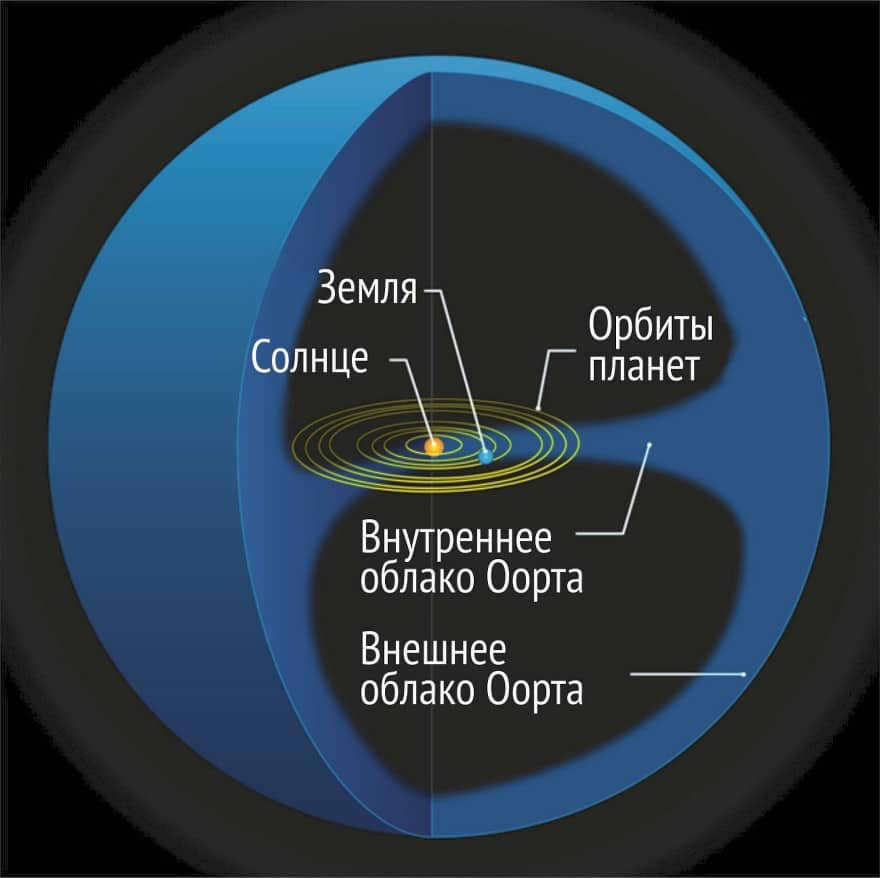
Most comets contain water, ethane, ammonia, methane, hydrogen cyanide, and carbon monoxide. Around 1-2% of their composition may consist of asteroidal objects.
The Origin of the Oort Cloud
Scientists believe that the Oort Cloud is a remnant from the original protoplanetary disk that formed around the Sun’s star 4.6 billion years ago. These objects could have merged closer to the Sun, but interactions with large gas giants caused them to be pushed out to a considerable distance.
A recent study conducted by NASA scientists has revealed that the vast number of objects in the Oort Cloud is the result of an exchange between the Sun and neighboring stars. Computer models indicate that galactic and stellar tides alter the orbits of comets, causing them to become more circular. This phenomenon may explain why the Oort Cloud has a spherical shape.
Simulations have also verified that the formation of the outer cloud aligns with the theory that the Sun originated in a group of 200-400 stars. The presence of ancient objects may have impacted the formation process due to their greater numbers and increased frequency of collisions.
Oort Cloud Comets
It is hypothesized that these entities peacefully wander within the Oort Cloud until they are disrupted from their typical trajectory by a gravitational disturbance. This phenomenon transforms them into long-period comets that venture into the outer regions of the solar system.
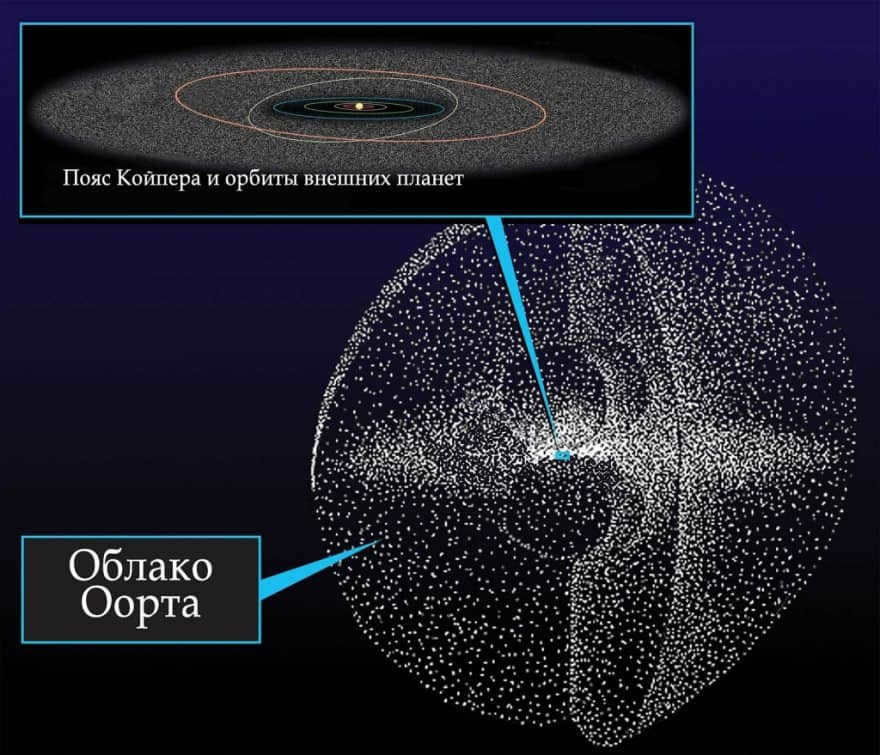
Comparing the sizes of the Oort Cloud and the Kuiper Belt can be quite fascinating. Short-period comets have orbits that last for a couple of hundred years, while long-period comets can have orbits stretching for tens of thousands of years. The Kuiper Belt is the source of the former, while the Oort Cloud is where the latter originate from. Of course, there are always exceptions to the rule.
Take, for example, the comets of Jupiter and Halley. While they are considered short-period comets, they actually come from the Oort Cloud. It is believed that they were originally long-period comets, but were influenced and affected by the gravitational pull of the gas giant planet.
Exploring the Oort Cloud
Despite our efforts, we have yet to reach the Kuiper belt, and the Oort Cloud poses an even greater challenge due to its remote location. Currently, Voyager 1 holds the record for the farthest distance traveled, but it still has a considerable journey ahead. Taking into account its current acceleration, this interstellar spacecraft will require another 300 years to reach its destination and a staggering 30,000 years to completely traverse the cloud.
Following in its footsteps, Pioneer-10 and 11, Voyager 2, and New Horizons will embark on their own missions to explore the Oort Cloud. However, it is unfortunate that these spacecraft may encounter malfunctions that prevent them from transmitting any signals back to us.
Therefore, the primary challenge in exploring it lies in the immense distance. When the probe finally reaches its destination, centuries will have passed. At present, our focus is limited to observing the incoming comets. Now that you have familiarized yourself with the locations of the Kuiper Belt and the Oort Cloud, you have gained insight into the celestial bodies and their movement within the solar system.
If we were discussing space two decades ago, the discussion about the solar system would have concluded with Pluto, the former outermost planet. Nevertheless, in today’s understanding, we acknowledge that the planets merely mark the beginning and that the solar system stretches far beyond our previous imagination.
When measuring distances in the Solar System, scientists often use the concept of “astronomical units” (a.u.). An astronomical unit is defined as the distance from the Earth to the Sun, which is approximately 150 million kilometers or 8 light-minutes. Therefore, the distance from the Sun to Mars is approximately 1.5 a.u., while the distance from the Sun to Jupiter is about 5.2 a.u. Furthermore, the distance from the Sun to Neptune is roughly 30 a.u.
Table of Contents
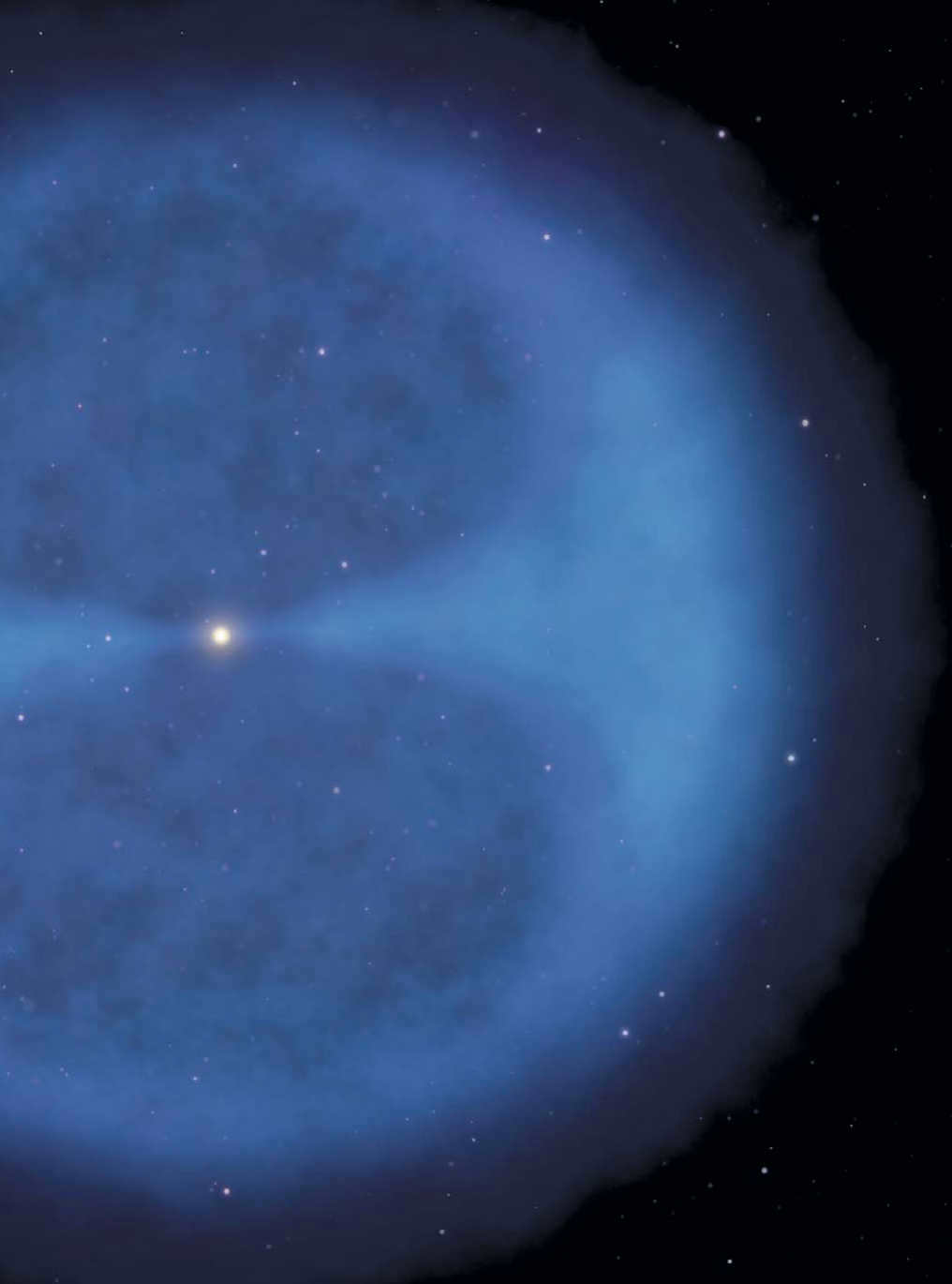
An artist’s depiction of the composition of the Kuiper Belt and the Oort cloud surrounding the Sun.
A Brief Overview of the Kuiper Belt and the Oort Cloud
- The Kuiper Belt was discovered by David Jewett and Jane Lu in 1992.
- The Oort cloud hypothesis was proposed by Ernst Epic and Jan Oort in 1932.
- The Kuiper Belt is located at a distance of 30-55 astronomical units from the Sun.
- The Oort cloud is located at a distance of 5000-100,000 astronomical units from the Sun.
- Some known plutoids and their average distances from the Sun are Pluto – 39 astronomical units, Haumea – 43 astronomical units, Makemake – 46 astronomical units, and Erida – 68 astronomical units.
Stretching from the orbit of Neptune to about 55 a.u. from the Sun, a colossal structure called the Kuiper Belt encircles our solar system. At the heart of this cosmic donut lies the Kuiper belt, named after Gerard Kuiper, a Danish astronomer who was among the first to predict its properties back in 1951.
Primarily composed of presumed planetesimals left over from the formation of our solar system, the Kuiper Belt has been likened to a “garbage dump” by some. However, it is more likely that this cluster of remnants is the result of the protoplanetary disk from which our solar system originated. These remnants have managed to survive the migration of Uranus and Neptune to their present-day orbits.
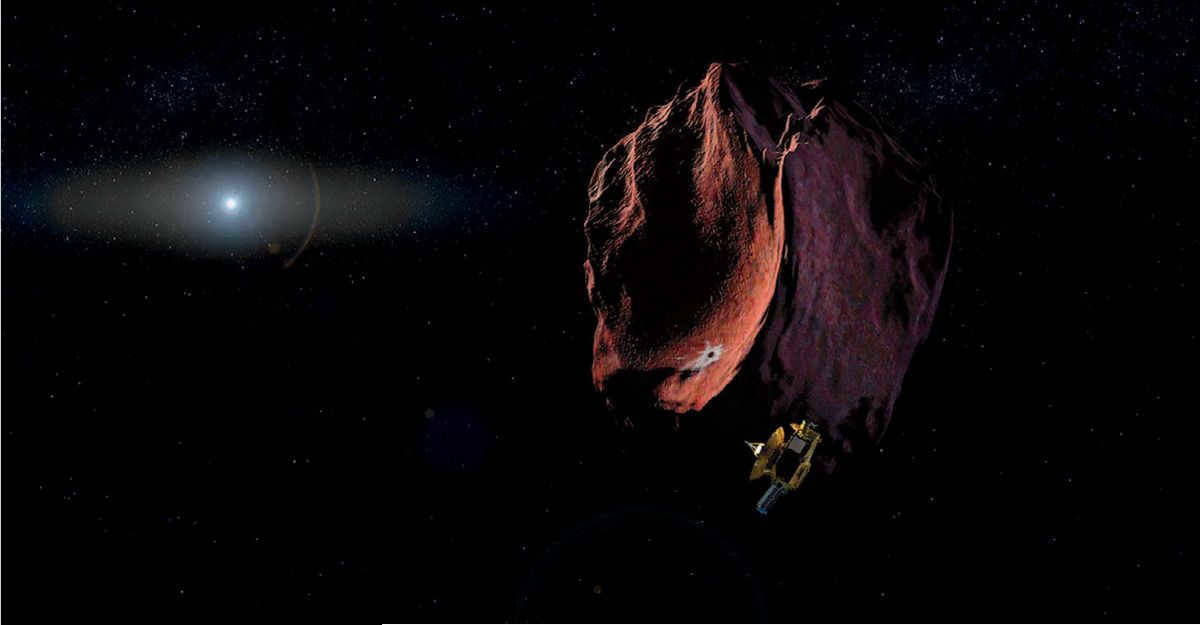
The artist has depicted typical Kuiper Belt objects in this image. In order to include all the objects in one illustration, he has arranged them in closer proximity than they would be in reality. Similar to the asteroid belt, the Kuiper belt consists mostly of empty space.
Up to this point, this formation resembles a mere silhouette; it encompasses merely a fraction of Earth’s overall mass, accounting for no more than 10%. Since 1992, through the examination of telescopes focused on the Kuiper Belt, scientists have uncovered over 1,000 objects classified as part of it (OCOs), and researchers anticipate the discovery of even more. Following its encounter with Pluto, the New Horizons spacecraft proceeded to visit a diminutive asteroid known as 2014 MU69, hailing from the Kuiper Belt, on January 1, 2019, marking it as the most remote object ever surveyed by a terrestrial probe, with a distance of 6.5 billion kilometers. Pluto is now recognized as the foremost identified Kuiper Belt object, rather than a planet, and it is now acknowledged that Neptune’s moon Triton was ensnared by the gigantic DIC entity.
Observations using instruments have continued through the Pan-STARRS (Panoramic Survey Telescope and Rapid Response System) service. The service was initiated in 2008 with a telescope located at the top of the Haleakala volcano in Hawaii. Its purpose is to track comets and asteroids that may pose a threat to Earth. Additionally, the service produces a detailed map of faint celestial objects, including DICs.
Outside of the Kuiper belt, there exists a desert region where objects with highly elongated orbits, known as the scattered disk, reside. This region extends within 100 a.e. (astronomical units) of the Sun. Unlike stable DICs, objects in the scattered disk can venture as far as 30 a.e. from the Sun, where they can be influenced by the gravitational field of Neptune. The scattered disk is considered to be a dynamically active region that serves as the origin for short-period comets. These comets have orbits of shorter duration.
Different Types of Dwarf Planets
While exploring the Kuiper belt, it is important to mention a few interesting objects that have been discovered beyond Neptune’s orbit. One such object is Erida, which is actually larger than Pluto and is classified as a scattered disk object. Erida was first spotted in 2005 by astronomer Mike Brown and his team at the Palomar Observatory. Initially, it was given the name Xena, inspired by a popular television character.
Erida is currently located about 97 astronomical units away from the Sun, which is much farther than the Kuiper Belt. In fact, it holds the record for being the most distant object ever found within our solar system. While there have been nearly a dozen planet-like objects discovered in the Kuiper Belt, astronomers are eager to continue their search for more. Additionally, there is a speculation that there might be a ninth planet lurking beyond the boundaries of the Kuiper Belt, a planet that could be ten times more massive than Earth.
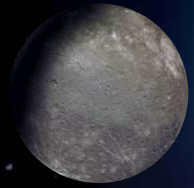
An illustration of the dwarf planet Erida created by an artist.
One more unusual finding was the small planet Sedna. It was discovered in 2003 by Brown’s team and is smaller than Pluto, but its orbit is very peculiar. At present, Sedna is located at a distance of 88 astronomical units from the Sun and never gets closer than 76 astronomical units. In other words, it is well beyond both the Kuiper Belt and the planetary system. Astronomers have estimated that its maximum distance from the Sun could be an astonishing 975 astronomical units. We haven’t explored that far yet. There are no plans to send a spacecraft to Sedna, but it is estimated that a satellite would take over 25 years to reach the point of closest approach to the Sun. Sedna’s remarkable distance from the Sun has led Brown to suggest that it might not be a scattered disk object at all, but rather the first “resident” of the Oort cloud. And that brings us to the final part of our story.
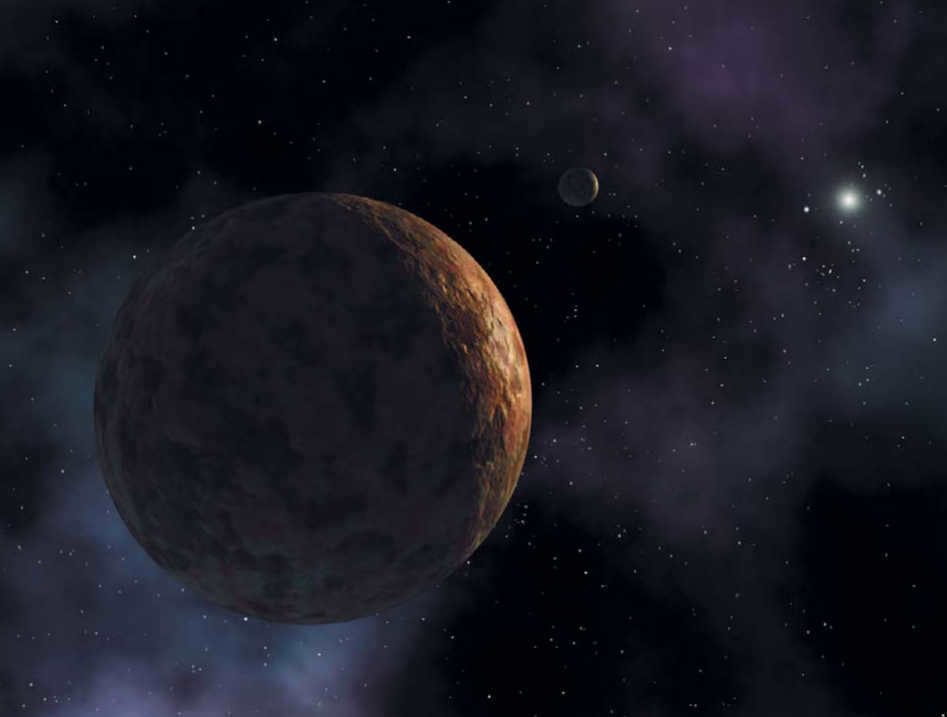
Plutoid Sedna can be found in the Kuiper Belt. The Sun, a brilliant star, and Sedna’s hypothetical companion, whose existence was suspected at the time of the plutoid’s discovery but not officially confirmed, are both present in this region. When observed through a telescope, Sedna appears reddish in color.
The Oort Cloud
In 1950, Danish astronomer Jan Oort proposed the idea of a source of comets located in the outer regions of the solar system. His reasoning was straightforward: comets cannot remain intact indefinitely, as they lose mass each time they approach the Sun and experience gravitational influences from the planets. Therefore, if comets are still visible, there must be a mechanism for the creation of new ones. Oort theorized that this mechanism existed in a region beyond the orbit of Pluto, resembling a vast warehouse for comets.
Based on current theories, this area is believed to be an enormous mass of gas and dust that stretches from a few thousand astronomical units to potentially even greater distances. Known as the Oort cloud, it is comprised of two sections – an inner region shaped like a bagel, with its outer edge located approximately 20,000 astronomical units from the Sun, and an outer section that is sparsely populated and spherical in shape. Scientists hypothesize that the Oort cloud is made up of remnants from the early formation of the solar system, when objects that originally formed near the Sun were flung out into space about 4 billion years ago.
The Oort cloud may serve as the primary source for long-period comets, including Halley’s Comet, even though it may seem peculiar at first glance. Halley’s Comet has an orbital period of only about 72 years, but it likely originated in the Oort cloud and transitioned into its current short orbit due to the gravitational influence of the planets. Most comets with periods shorter than 200 years, known as short-period comets, are believed to have formed in a scattered disk.
As is typical with such distant and enigmatic regions, astronomers propose fascinating theories regarding the origins of the Oort cloud’s prominent inhabitants. One such theory suggests that they were captured from a passing star. Thus, our quest to explain what lies in the solar system’s backyard and our immediate vicinity naturally leads us to the realm of the stars. And our next destination? The spiral arms of our galaxy, the Milky Way.
Distinguishing Fact from Fiction in the World of Science
Previously, there was a belief that the asteroid belt was the remains of a planet that had exploded. This concept provided the foundation for the fictional story of Superman’s home planet Krypton. However, in reality, the asteroid belt is quite the opposite: it consists of particles that never coalesced into a planet. During the early stages of the solar system, Jupiter was located much closer to the Sun, and its gravitational forces expelled a significant portion of the matter that now comprises the asteroid belt. The overall mass of the asteroid belt is quite scant, amounting to no more than 10% of what is necessary for planet formation.
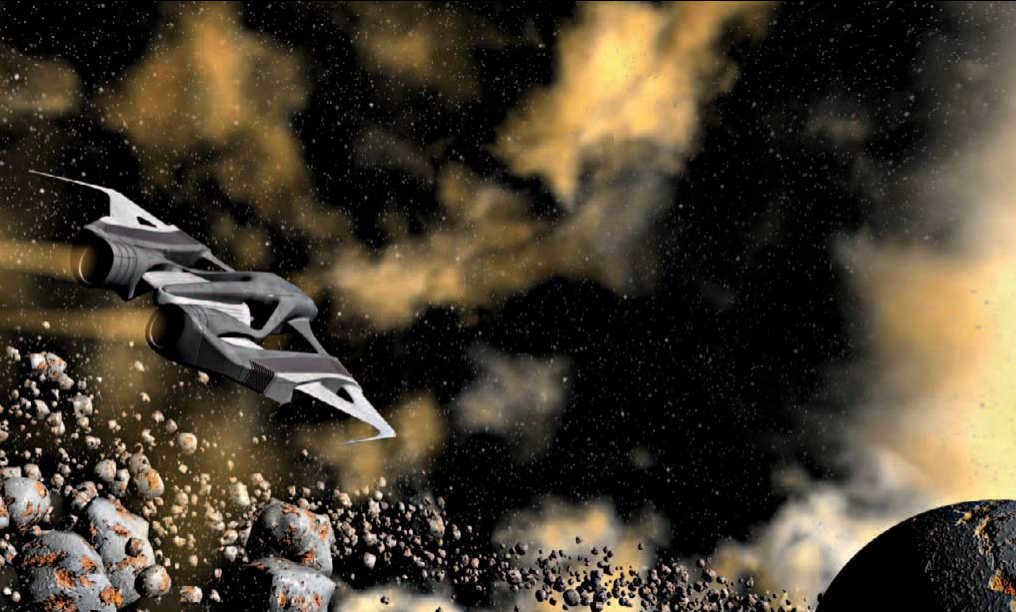
It should be noted that the representation of the asteroid belt in science fiction movies as a space filled with boulders that a spaceship struggles to navigate through is completely inaccurate. In reality, the asteroid belt is more like a barren wasteland, similar to the Kuiper belt. Numerous spacecrafts have already passed through the asteroid belt on their way to the outer planets, encountering only tiny particles of sand along the journey.
To be more precise, the universe and solar system contain various different elements, each serving a unique purpose within the solar system.
Major discoveries
- The Kuiper Belt, situated beyond Neptune in the Solar System, primarily consists of small icy celestial bodies. Conversely, the Oort Cloud is a hypothetical spherical cloud enveloping the Solar System that houses icy bodies and comets.
- The Kuiper Belt is relatively close to the Sun and harbors objects with shorter orbital periods, whereas the Oort Cloud is significantly more distant and accommodates objects with longer orbital periods.
- Kuiper Belt objects are believed to be the origin of short-period comets, while Oort Cloud objects are believed to be the source of long-period comets.
What sets the Kuiper Belt apart from the Oort Cloud is their distinct shapes. The Kuiper Belt takes the form of a disk, while the Oort Cloud exhibits a spherical shape. In addition to their differing appearances, these two entities possess other unique characteristics.
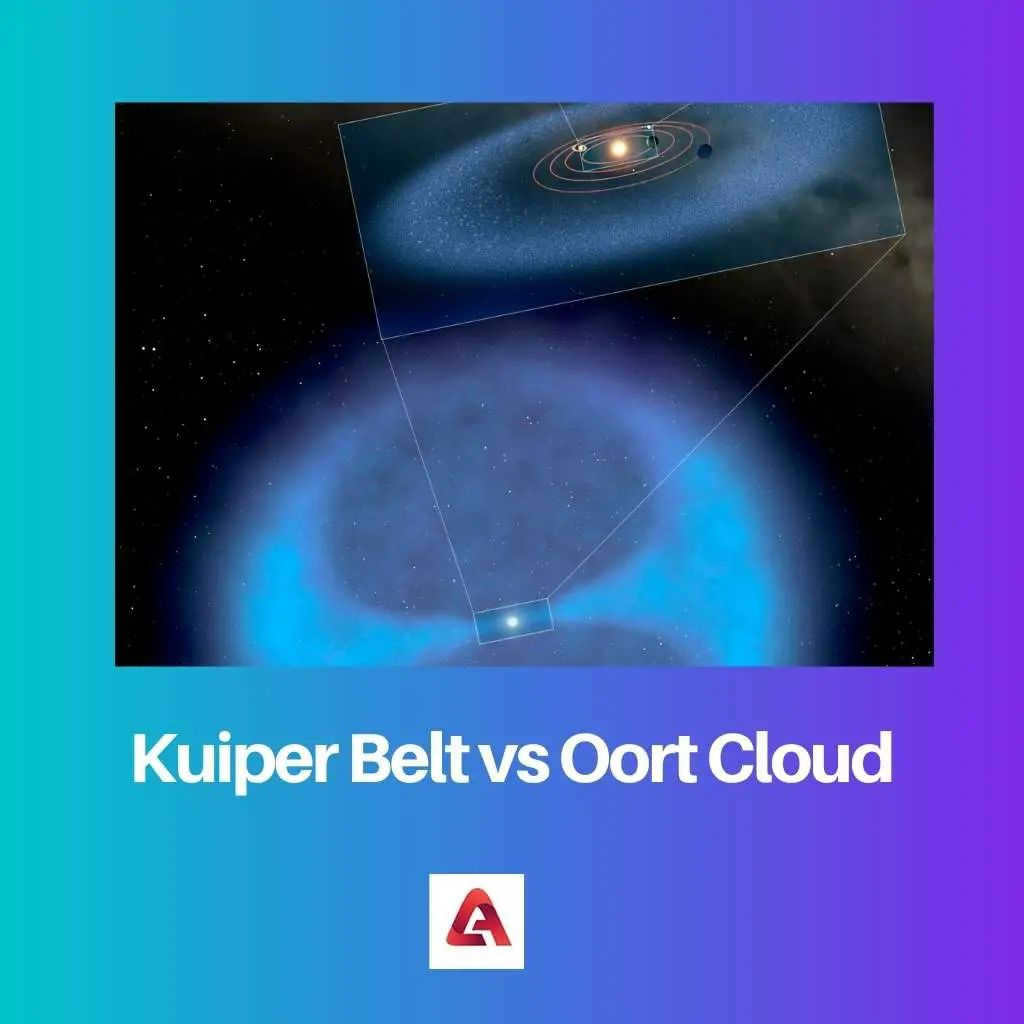
The area in the solar system resembling a belt of asteroids is called the Kuiper belt.
The Oort cloud is a theoretical concept that describes a cloud-like structure that existed in the early stages of the solar system and was located at a specific distance from the Sun.
Comparison chart
What is the Kuiper belt?
The Kuiper belt is a disk-shaped structure located in the solar system around a star resembling an asteroid belt. It is composed of methane, ammonia, and water.
Although there are similarities between the Kuiper belt and the asteroid belt, the Kuiper belt is significantly larger in size. It is named after the Dutch astronomer Gerard Peter Kuiper.
In 1992, a small planet named Albion was discovered within the Kuiper belt. Initially, it was believed that the Kuiper belt served as a collection of short-lived comets.
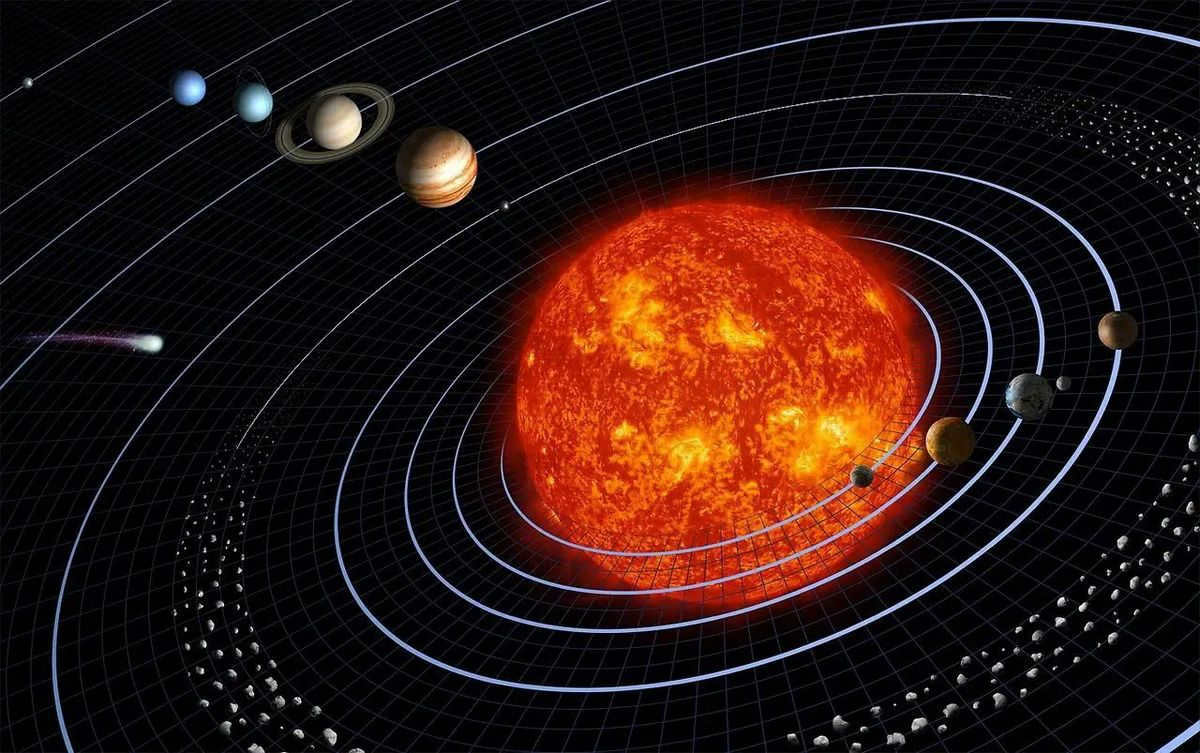
In order to investigate the Kuiper belt, the New Horizons probe was launched on January 19, 2006. The primary objective of this mission was to locate and study various celestial bodies within the Kuiper belt.
The Oort cloud is a theoretical concept that refers to a cloud that existed during the early stages of the formation of the solar system. It was located in proximity to the Sun within a specific range of distances.
The Oort cloud is divided into two regions: the inner Oort cloud, also known as the Hills cloud, which has a disk-like shape, and the outer Oort cloud, which is spherical in shape.
A significant number of long-lived comets can be found in the Oort cloud. Comets that have an orbital period of more than 200 years are classified as long-lived comets.
In addition to comets, the Oort cloud also contains asteroids, making it an essential component of the solar system. It is considered to be the boundary of the solar system.
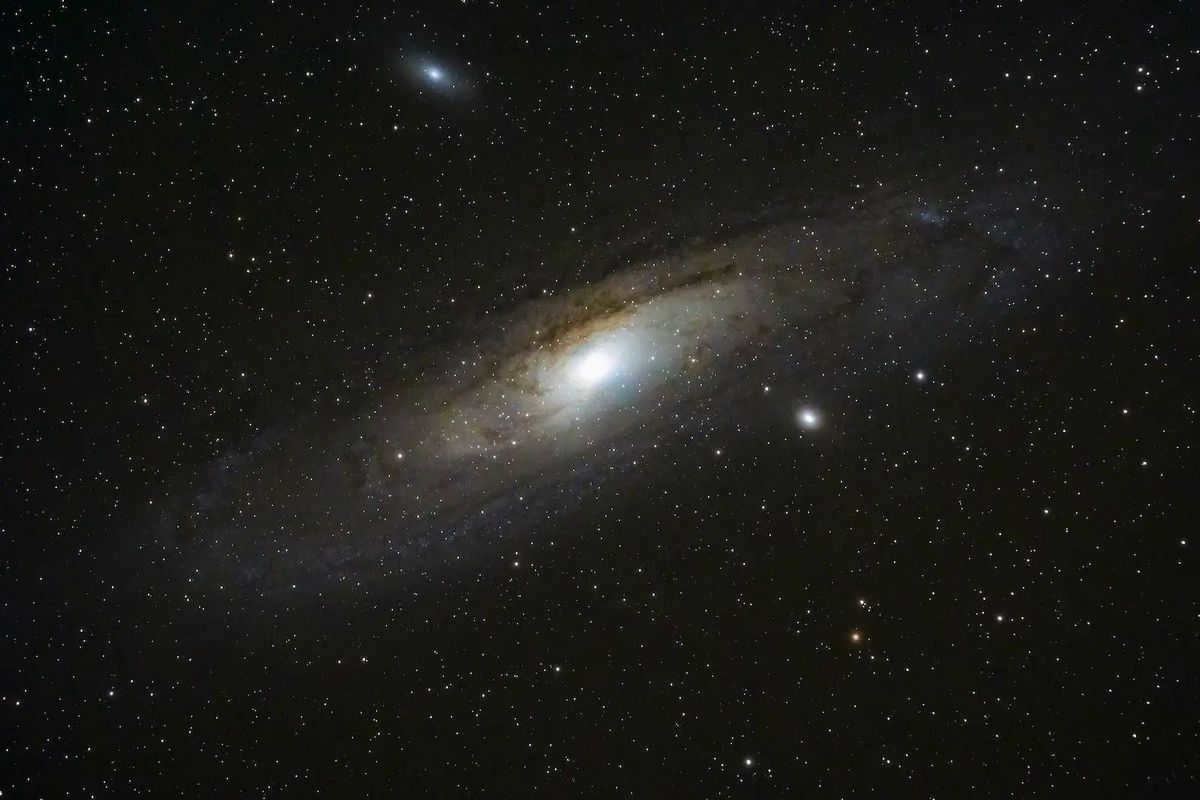
What sets the Kuiper belt apart from the Oort cloud
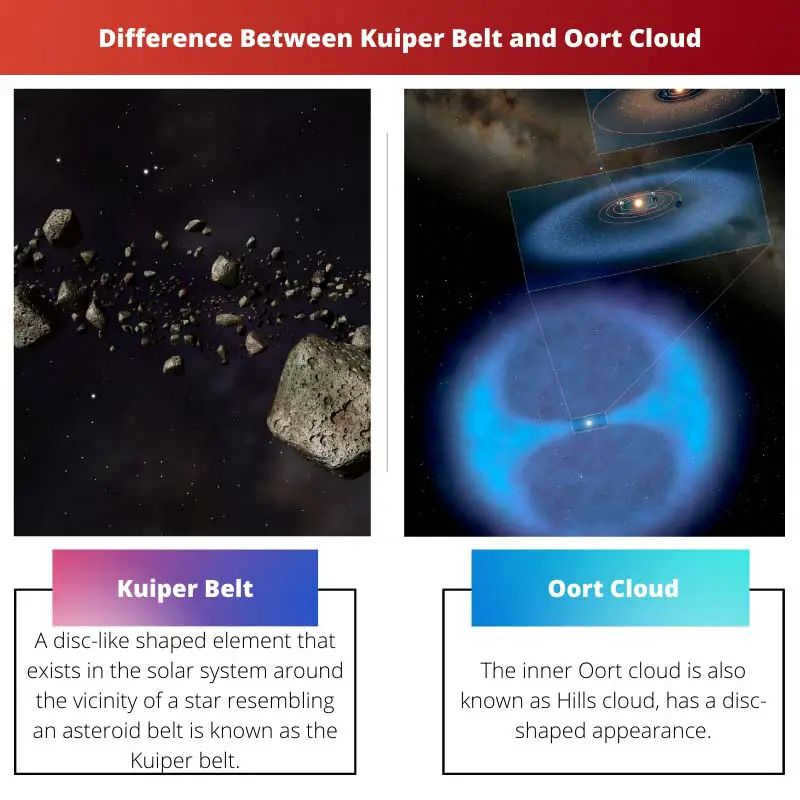
- The Kuiper Belt gets its name from the Dutch astronomer Gerard Peter Kuiper, whereas the Oort Cloud is named after the Dutch astronomer Jan Hendrik Oort.
- Objects in the Oort Cloud are dispersed around stars or the Sun, while objects in the Kuiper Belt are not dispersed towards stars or the Sun.
I have dedicated a lot of time and effort to crafting this blog post in order to offer you valuable information. It would greatly benefit me if you consider sharing it on social media or with your friends and family. Feel free to spread the love ♥️
Piyush Yadav has been an active physicist within our local community for the past 25 years. He is extremely passionate about bridging the gap between science and our readers. Piyush holds a Bachelor of Science degree as well as a Graduate Diploma in Environmental Science. For more information about him, please visit his bio page.
When delving into the topic of the Kuiper Belt, it is essential to acknowledge its primary representatives, Pluto and its primary moon, Charon.
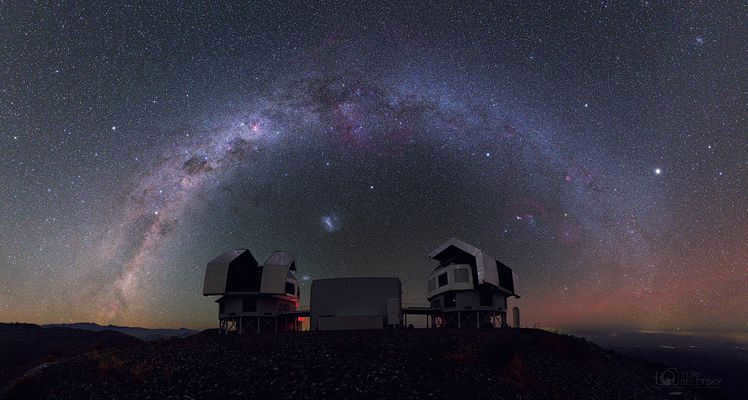
Observing from the Las Campanas Observatory in Chile, staff members of the Carnegie Institution have the privilege of gazing up at the magnificent Milky Way. The domes of the observatory provide a unique vantage point, allowing astronomers to study the wonders of the universe. Just below the mesmerizing “arc of stars” that stretches across the sky, the Large and Small Magellanic Clouds can be seen. These galaxies, which are the closest to our own, add to the grandeur of the celestial spectacle.
Our star is situated at a considerable distance from the center of the Milky Way, approximately two-thirds of its radius away. The planetary system surrounding it can be roughly categorized into three separate regions: the innermost section housing solid celestial bodies, the middle region inhabited by gas giants, and the outermost area comprised of icy formations. To measure distances within this solar system, I will be utilizing what is known as an “astronomical unit” (a.u.), which represents the average distance between the Sun and the Earth. Our home planet, along with other rocky neighbors, falls within the first region. The second region contains colossal planets primarily composed of hydrogen and helium. As for my research, I am focused on studying objects located within the third region, which is predominantly composed of ice – specifically water, methane, and ammonia. The temperature in this particular area is extremely low, causing substances that we typically see in a gaseous state to freeze. Additionally, there are several dwarf planets that are known to exist within the outer region.
There are two areas in the solar system where there are accumulations of debris that did not originate from the larger planets during their formation. The initial area, situated between the orbits of Mars and Jupiter, is known as the Main Asteroid Belt and is primarily composed of rocky objects. The second area, known as the Kuiper Belt, is positioned beyond Neptune’s orbit and is predominantly comprised of icy formations.
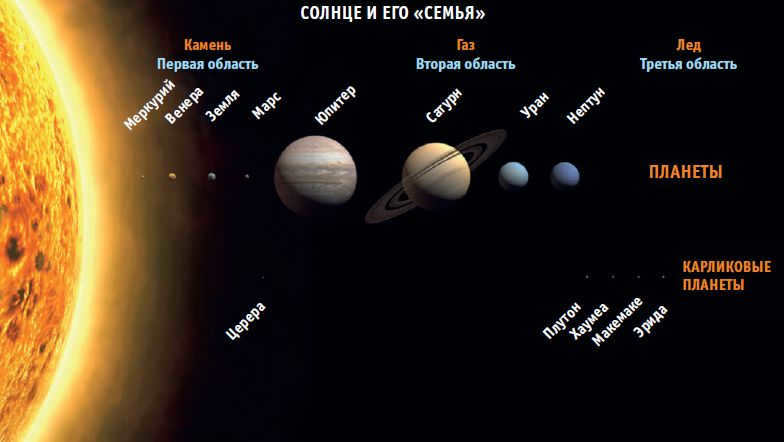
Pluto
For a considerable period, astronomers possessed minimal knowledge regarding the outermost region of the solar system. Pluto was first detected in 1930, and it was likewise acknowledged that comets likely originated from the distant fringes of the Sun’s “territory.” However, prior to this, we were completely unaware of the dimensions of this area or its precise composition.
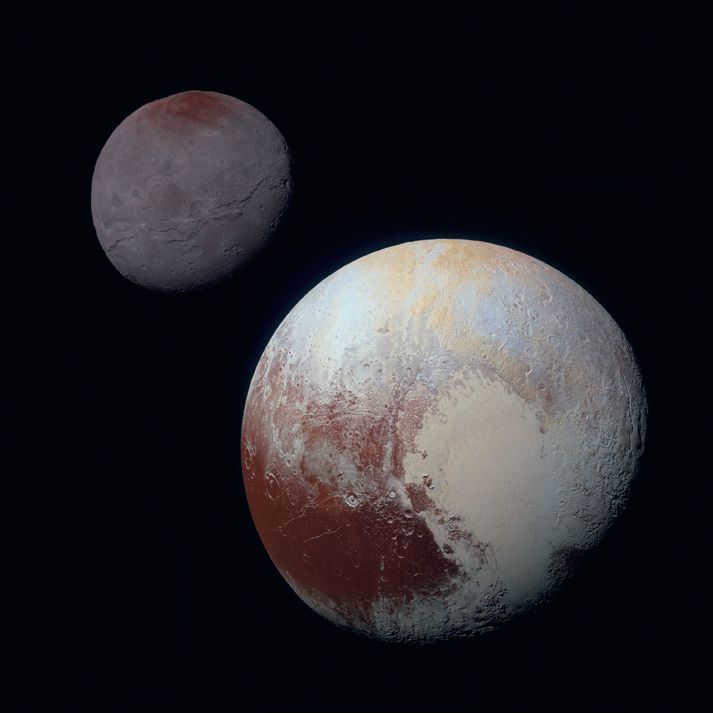
A compilation of images showcasing Pluto (located at the bottom right) and Charon, captured by the Ralph/MVIC (Multispectral Visual Imaging Camera) onboard the New Horizons spacecraft during its approach on July 14, 2015. The dimensions of these celestial bodies are depicted in accurate proportions, while the colors and brightness have been replicated through computer processing to closely resemble their natural appearance. Notably, the resemblance between the dark polar cap of Charon and the dark regions near the equator of Pluto is evident.
The New Horizons mission has provided us with the most comprehensive images of Pluto and its moons. This automated spacecraft flew close to the enigmatic dwarf planet, capturing highly detailed photographs. These images reveal a diverse array of features on Pluto’s surface, including the well-known heart-shaped landscape structure and areas that vary in darkness and light. Similar patterns can be observed on Charon, Pluto’s largest moon.
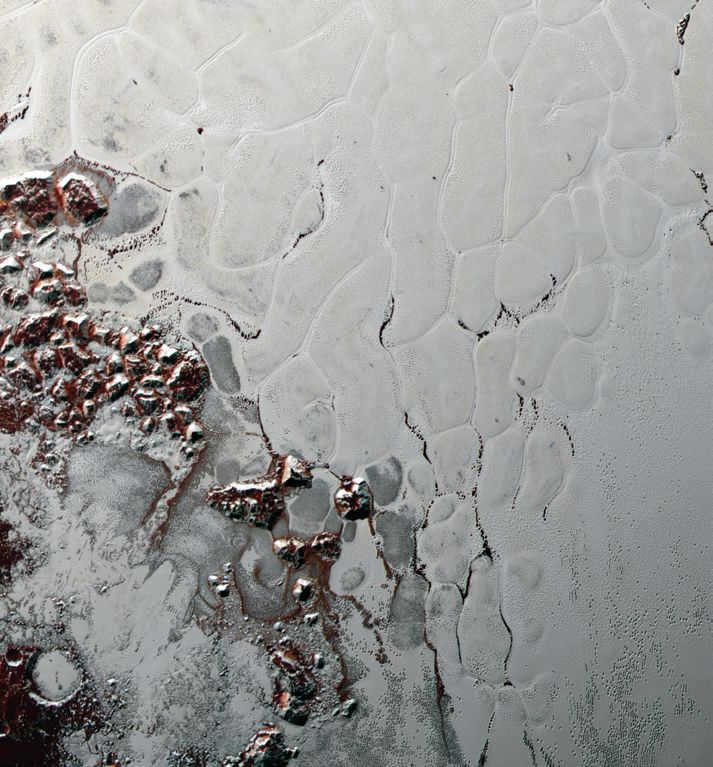
The frozen nitrogen on the surface of the dwarf planet forms ice that has a relatively new appearance. The nitrogen glacier displays irregular polygons with streamlined shapes, which suggest ongoing convective flows within its layers. These flows are sustained by the energy from a hidden ocean of liquid water and ammonia deep within the dwarf planet.
Scientists were greatly surprised by the incredible diversity they discovered on Pluto. Instead of the frozen desert world they expected, they found a bustling environment. The famous “heart” on Pluto’s surface is actually a plain made of nitrogen ice. It is believed that a massive crater formed in this area after a collision with another celestial body in the distant past, and it filled with liquid nitrogen that eventually solidified. If you examine the ice closely, you can see a pattern that vaguely resembles a honeycomb created by convection currents, similar to those seen in boiling water. As a result of heat exchange processes within each cell, the nitrogen ice moves upward at the center and sinks downward at the edges. The movement is slow, only a few centimeters per year, but it allows the surface to be completely refreshed over the course of a few million years. This process explains the “youth” and activity of the surface structures in this region, some of which may be less than a million years old.
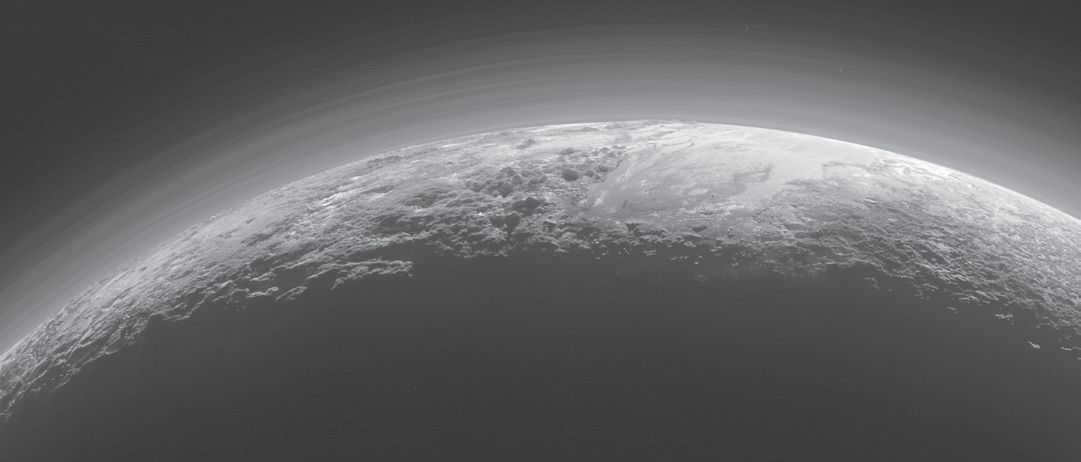
The layers of atmosphere on Pluto. After reaching its closest point to Pluto on July 14, 2015, the New Horizons spacecraft quickly turned around and captured an image of the dwarf planet’s atmosphere from a distance of 18,000 km. The atmosphere was beautifully illuminated by the Sun, and the photograph also captured a portion of the illuminated Plutonian sickle, measuring approximately 1250 km in width. Near the terminator, the photo reveals rugged terrain with impressive mountains reaching heights of up to 3.5 km. Scientists have identified over a dozen layers of haze in the thin atmosphere of Pluto.
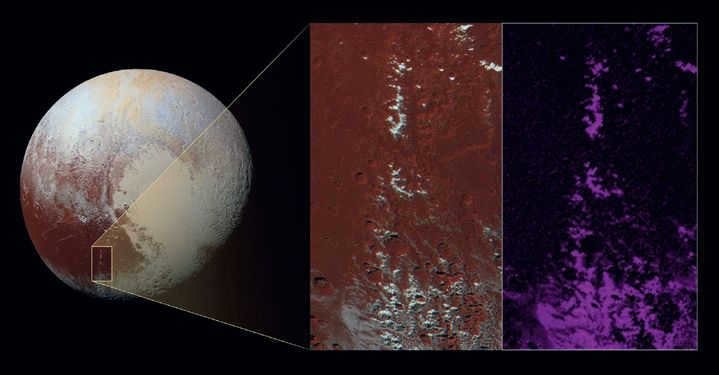
Methane snow has blanketed the peaks of mountains. The large dark area in the southern hemisphere of Pluto, informally known as “Cthulhu Regio,” has an extremely uneven terrain featuring mountain ranges with individual peaks that reach heights exceeding 3 km and lengths of 420 km. Some parts of these highlands are covered in bright white “caps,” which are believed to be made up of methane snow. The rest of the surface is a reddish-brown color due to the presence of tholins, complex molecules that form when methane breaks down and reacts with solar radiation. The resolution of the image mentioned above is approximately 680 meters per pixel.
So what do we know about Pluto? It’s believed that there is a small rocky core at the center of the dwarf planet. The interior of Pluto is thought to be a combination of rock and water. The surface is predominantly covered in water and nitrogen ice. This means that Pluto is primarily made up of ice. In terms of size, it is smaller than our Moon. The gravity on Pluto is only 6.6% of that on Earth. To put it into perspective, if the maximum height of a jump on Earth is 3 meters, on Pluto it would be possible to jump a staggering 45 meters. So, playing basketball on Pluto would be quite convenient.
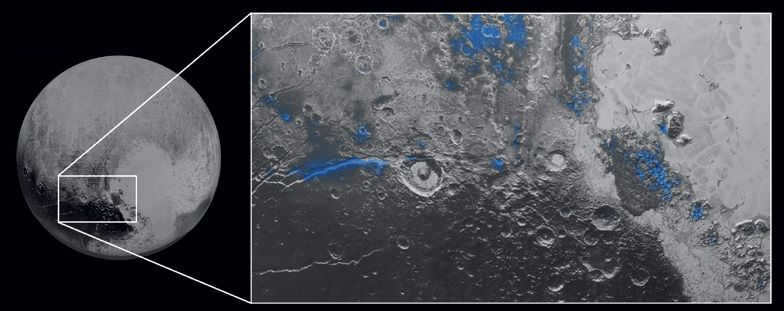
There are water ice formations shown in blue in this image, which was created using data from the spectrometer on the New Horizons probe. The LEISA instrument, which uses infrared spectroscopy, was used to collect the data. The image covers an area that is 450 km wide.
While there were many incredible discoveries waiting for us on Pluto, perhaps the most astounding ones are related to its atmosphere. Numerous photographs of the planet’s gas envelope clearly display multiple layers of haze stacked on top of each other. Within the gases surrounding the dwarf planet, various substances are suspended in the form of tiny dust particles. It is believed that the differences in chemical composition between the atmospheric layers depicted in the photographs are responsible for their formation.
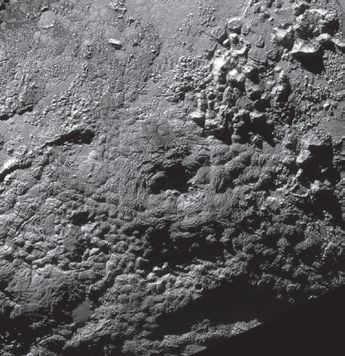
A fascinating formation at the center, informally known as “Wright Mountain” (Wright Mons), measures approximately 160 km in diameter and reaches a height of around 4 km. Indications suggest that it might be an ancient cryovolcano that once erupted streams of water-ammonia “lava”. Another larger elevation on Pluto, called Piccard Mons, exhibits a similar structure.
The landscape of Pluto is remarkably varied, with reddish-brown hills and mountains often juxtaposed with nearly flat regions covered in white nitrogen ice.
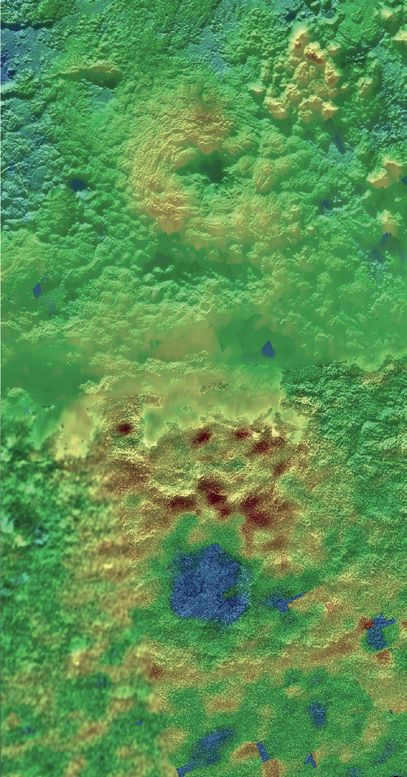
A map depicting the area surrounding Mount Wright and Mount Picard (shown in the lower part of the image) has been created using data collected from the New Horizons probe. Regions that fall below the average surface of Pluto are indicated by the color blue, while green represents areas with roughly average values. Yellow is used to highlight elevations, and the highest peaks are denoted in brown.
Charon’s distinctive features are immediately noticeable, with its deep and intricate valleys and canyons, as well as a prominent large dark red spot that contrasts against the gray surface. When comparing Charon’s largest canyon to the famous Grand Canyon in Arizona, it could be aptly named the “Big-Big Canyon”, as it reaches a depth of approximately 11 kilometers from the base to the upper edge. Our theory is that this immense canyon was formed due to the presence of an underground ocean on Charon. As we all know, water expands when it freezes, and it is highly likely that during a relatively short period of time, this liquid ocean froze and expanded, leading to the formation of these impressive gorges.
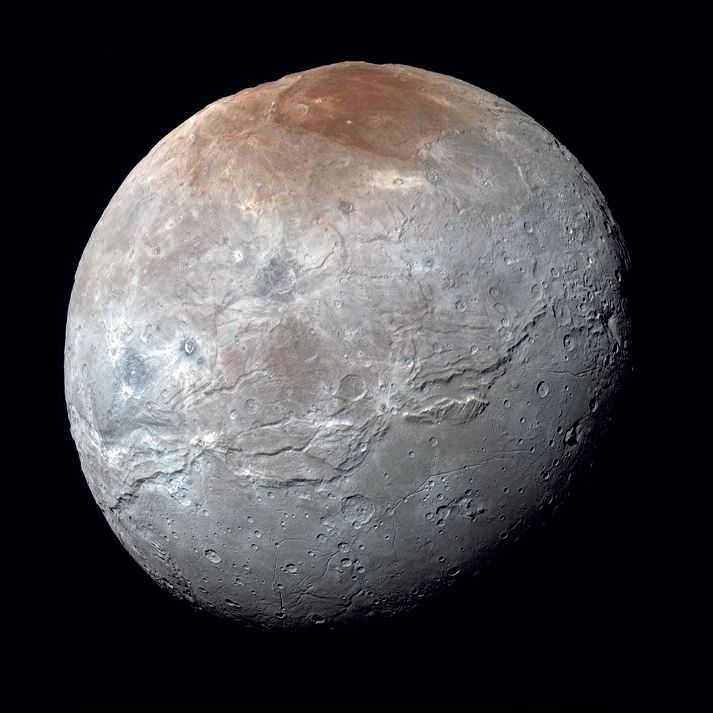
The New Horizons spacecraft captured a general view of Charon, one of Pluto’s moons, before its closest approach on July 14, 2015. The image was created using a combination of images taken with the Ralph/ MVIC spectrograph, which used blue and red light filters, as well as near-infrared. This allowed for a resolution of up to 2.9 kilometers per pixel.
It is interesting to note that while canyons can be found on Pluto, they are not as deep as those seen on Charon. It would be expected to see similar canyon formations on both celestial bodies, but this is not the case. This could suggest that liquid water may still exist beneath the surface of Pluto, potentially hiding a large ocean within the depths of the dwarf planet.
However, Pluto also has a similar feature – a dark red polar region. It is believed that the dark areas on Pluto’s surface may have contributed to the colored material found on Charon. The organic molecules responsible for the reddish color could have been transferred to the moon along with atmospheric gases. The temperature near Pluto’s poles is about 10° colder than at the equator, which is where the dark red spot is located. It is likely that in this region, the molecules carried by gas exchange freeze and gradually settle.
In addition to Charon (the largest moon), Pluto has four additional small moons. Because of the small size of the smallest moons, Kerbera and Styx, as well as their significant distance from the spacecraft, it was not feasible to conduct a thorough examination of these objects. The surface of the two larger moons, Nycta and Hydra, displays numerous craters. These small moons were formed around the same time as Charon and all orbit in a nearly identical plane. It is believed that they were created as a result of a collision between Pluto and another celestial object.
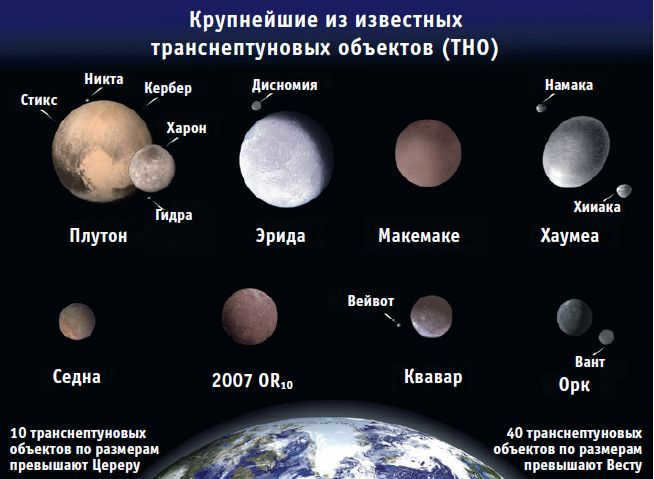
The Kuiper Belt
After passing by Pluto, New Horizons is now continuing its journey towards objects in the Kuiper Belt. In January 2019, it is expected to reach the first of these objects, which is not a dwarf planet like Pluto, but rather a much smaller body with a size of only about 30 km. This is comparable to the size of some of Pluto’s smaller moons. While Pluto has a significant mass, internal energy, and a core, the next destination of the mission is a typical building block that has not been incorporated into planets. It is unlikely that we will find any signs of internal activity on its surface. Currently, the best available images only show a small bright spot moving against the backdrop of stars. However, in less than two years, we will have a clearer view of this distant celestial body, with the ability to see craters and other details.
There is ongoing controversy surrounding Pluto’s classification as a planet. The debate stems from the fact that it took over 60 years to find another object similar to Pluto after its discovery in 1930. In 1992, an Englishman named David Jewitt, who was my science advisor at the University of Hawaii, made a groundbreaking discovery. He found an object in the Kuiper Belt that was comparable in size and orbital parameters to Pluto. This discovery proved that there could be many more objects like Pluto in the Kuiper Belt. It wasn’t until the 1990s when our technology advanced enough to make such observations and identify objects at such distant locations.
In the early 2000s, the group of dwarf planets was expanded with the finding of several new objects: Haumea, Makemake, and Sedna. However, up until 2010, there was no search for transneptunian objects in the Southern Hemisphere due to the lack of instruments with the necessary focal length. In 2010, the Las Campanas Observatory in Chile commenced its operations. Each of its two large reflectors boasts a diameter of 6.5 meters. Additionally, the observatory has the Henrietta Swope meter telescope, which, after undergoing improvements, became suitable for the exploration of new bodies in the Kuiper Belt. Consequently, numerous dwarf planets have been discovered. One of them, 2010 EK139, has a size exceeding 700 kilometers, which is roughly three times smaller than Pluto. Another dwarf planet, 2010 JJ124, measures approximately 600 kilometers in diameter.
With the method we employed, we have conducted extensive observations of the entire Southern Hemisphere sky using a one-meter telescope. This system enables us to detect objects with a brightness of up to the 21st magnitude and sizes ranging up to several hundred kilometers. However, if we were to utilize a telescope with a larger mirror diameter of 4 or 6 meters, we would be able to detect much fainter objects that are smaller or even more distant. In fact, the instrument we employed would not be able to perceive the Earth itself from a distance of several hundred astronomical units. It is certain that further advancements in technology will result in the discovery of numerous new celestial bodies within the Kuiper Belt.
What is this belt, exactly? Beyond the gas giants’ orbits lies a collection of small entities – the residue of matter that did not become part of the planets during their creation. Currently, around 2,000 entities have been identified. The most prominent dwarf planets in this group include Ceres, which is the largest body in the Main Asteroid Belt, measuring approximately 950 km in diameter, and Pluto, which is the largest known entity.
The largest dwarf planets are considered to be the following objects: Ceres, which is the largest body in the Main Asteroid Belt and measures approximately 950 kilometers in diameter; Pluto, which is the largest known object in the Kuiper Belt; however, Triton, a satellite of Neptune, is even larger (scientists believe it was captured by Neptune’s gravity from the Kuiper Belt). Another dwarf planet, Erida, is nearly the same size as Pluto. All of these objects are smaller than our Moon and significantly smaller than Titan and Ganymede, the largest moons of Saturn and Jupiter, respectively. This demonstrates that Pluto is not the only important object in the Kuiper Belt. Alongside it, there are Erida, Makemake, Haumea, Ork, and numerous smaller icy bodies.
Could Pluto still be considered a planet? Currently, it is officially categorized as a dwarf planet. However, regardless of its classification, whether as a full-fledged planet or a dwarf, what truly matters is its origin, formation processes, and relationships with other celestial bodies.
If you examine a map illustrating the positions of asteroids in the inner regions of the Solar System, it becomes evident that the majority of them are concentrated within the Main Belt, which lies between the orbits of Mars and Jupiter. Additionally, there are the Trojan asteroids, which have a 1:1 orbital resonance with Jupiter, orbiting the Sun near the orbit of this massive planet. Furthermore, there is the Hilda group, which exhibits a 3:2 orbital resonance with the gas giant. This signifies that the “Trojans” complete one full revolution around the Sun in the same amount of time as Jupiter, while the “Hildas” manage to complete three revolutions in two turns of the planet’s orbit. The members of the Hilda family are not evenly distributed – when viewed from above, their extended cluster resembles a triangle with angles corresponding to the Lagrangian points of the Jupiter-Sun system. This distribution ensures the stability of the asteroids’ orbits: if they circulated with different periods, they would eventually come too close to Jupiter and be pulled towards it by its gravitational force. The examination of the specific characteristics of the Hilda family’s orbits has led to the conclusion that Jupiter itself has shifted approximately half an astronomical unit closer to the Sun since its formation.
In this discussion, I will delve into the Centaurs, which are a collection of asteroids that are found scattered between the orbits of Jupiter and Neptune. The behavior of these celestial bodies is highly unpredictable, and they typically have a lifespan ranging from several hundred thousand to tens of millions of years. Eventually, the gravitational forces exerted by planets and other celestial objects either propel the centaurs towards the inner solar system, transforming them into comets that we can observe, or they are expelled from the solar system altogether.
Resonant transneptunian objects form another category of inhabitants in the Kuiper Belt. These objects have orbit characteristics that are similar to the previously mentioned Hilda family of asteroids, with the difference being that they are in resonance with Neptune instead of Jupiter. Similar to the behavior of the Hilda asteroids, we can infer information about the movement of the ice giant itself based on the behavior of these resonant bodies. Currently, it is believed that Neptune was formed 5-10 astronomical units (a.u.) closer to the Sun than its current position. Over time, it shifted to the outer regions of the solar system, consequently leading to the placement of these objects into resonant orbits.
Pluto also has a unique relationship with Neptune: it completes two orbits around the Sun in the time it takes Neptune to complete three. It’s worth noting that Pluto’s orbit is quite unstable, as it intersects with the much larger mass of Neptune. However, the resonance between the two objects allows Pluto to avoid getting too close to Neptune and being absorbed for a significant period of time, which is comparable to the current age of the solar system.
Similar to Jupiter, Neptune also harbors Trojan asteroids that share its orbit. However, due to their immense distance, the number of recognized “Trojans” around Neptune is relatively small compared to those around Jupiter – only a little over a dozen have been identified. These objects are characterized by their significantly inclined orbital planes, suggesting that Neptune’s orbit was much more eccentric in the distant past. When giant planets pass by clusters of similar bodies, their gravitational field strongly affects them, often causing them to scatter. Therefore, by studying the characteristics of Trojan asteroids, we can gain a better understanding of the tumultuous history of outer planets, particularly Neptune and Uranus.
Based on the data that is currently available, it can be inferred that the gas and ice giants originally formed in much closer proximity to each other than their current positions. Over time, as their distance increased, the gravitational interactions between these celestial bodies resulted in unpredictable movements and numerous collisions involving planets, asteroids, and fragments thereof. Fortunately, this era occurred in the distant past, and the present solar system is now a relatively calm and stable environment for us to inhabit.
Lastly, there exists a group of celestial objects known as scattered disk objects. These objects have highly eccentric orbits, with their closest approach to the Sun not far from the orbit of Neptune. Consequently, after coming near the giant planet, many of these objects are flung to the far reaches of the solar system. One example of this class is Erida, which is currently slowly moving towards its point of maximum proximity to Neptune.
The New Horizons spacecraft’s upcoming destination, known as koyperoid 2014 MU69, is a member of the classical transneptunian object family that formed in the outer reaches of our solar system. In contrast, Pluto is classified as a scattered disk object that was captured into its current orbit through interactions with other celestial bodies. As a result, the mission aims to investigate an object that belongs to a distinct class from Pluto.
Thanks to research on small celestial bodies, we now have a wealth of knowledge about the giant planets in our Solar System. It appears that Jupiter has actually migrated closer to the center of the Solar System since its formation, while Saturn, Uranus, and Neptune have moved in the opposite direction, towards the outer regions. Interestingly, the most distant planet in our system likely formed even closer to the Sun than Uranus’ current orbit. Many objects that formed in the same regions as the larger planets have been pushed to the outskirts of the Solar System, where some of them, like Pluto, now orbit in highly inclined paths. Another group of objects in the Kuiper Belt are considered “natives”. These objects are characterized by their reddish color and low orbital inclination, and they tend to be smaller in size compared to the objects in the first group.
However, there are also some incredibly unique distant objects, such as Sedna and 2012 VP113, that exhibit very peculiar behavior and do not come as close to the giant planets, Pluto, or the large bodies of the Kuiper Belt as expected. It is possible that the unusual orbits of these objects can be explained by the existence of another planet that lies beyond the capabilities of current telescopes, guiding Sedna and 2012 VP113 along unexpected paths. However, this topic is already the focus of a separate report.
Going back to the distant year of 1950, astrophysicist Jan Oort from Holland proposed the idea that all comets are actually formed in a single location – a cloud surrounding the inner regions of our solar system. This region is now referred to by scientists as the Oort cloud. The Oort cloud marks the boundary of our solar system.
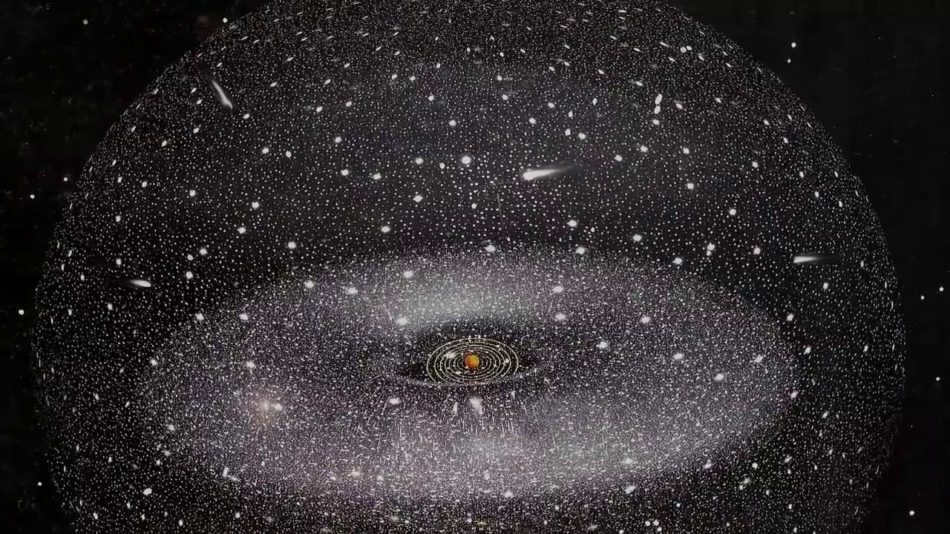

Gaining a deeper understanding of the topic
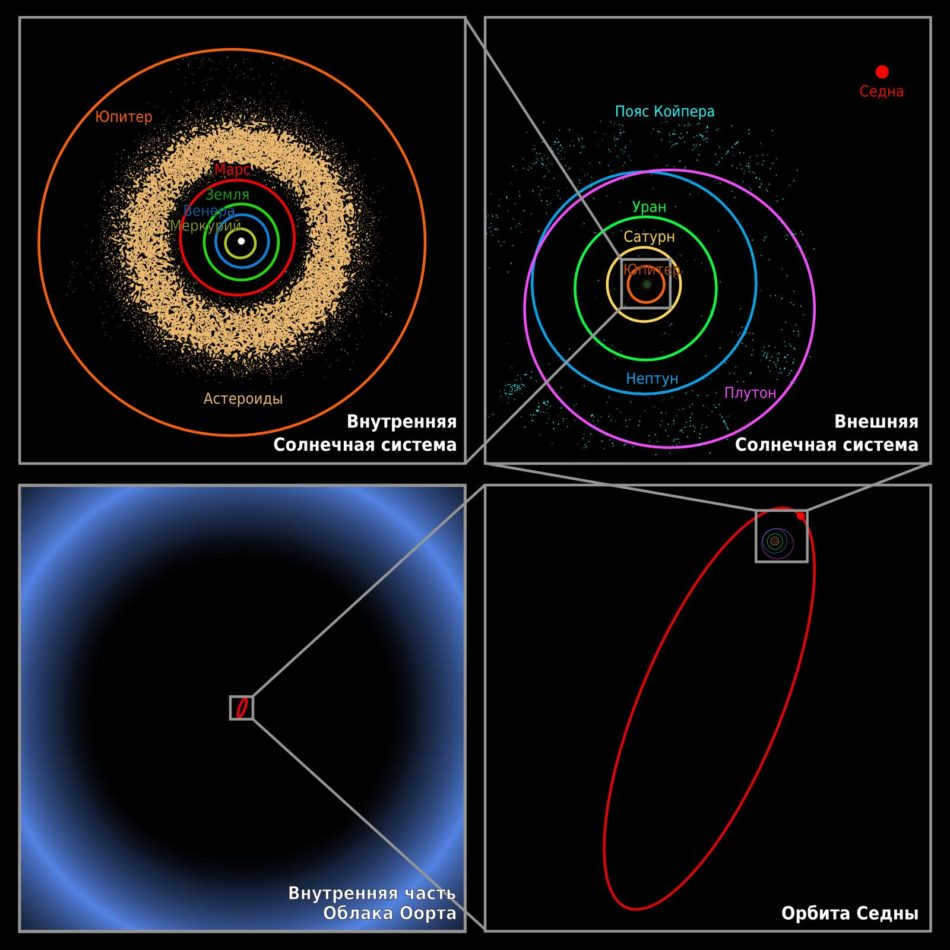
The composition of the Kuiper Belt and the Oort Cloud, and why comets originate from it, are topics of great interest.
Comets are celestial bodies that can often be observed near the Sun. They vaporize and are carried away from the Sun by cosmic winds. The elongated shape of their orbits is evidence that comets come from very distant parts of the solar system. Astronomers track the motion of around twelve comets each year. However, astronomers are not the only ones interested in studying celestial bodies. Astrophysicist Jan Oort proposed a hypothesis that all comets originate from a distant cloud that surrounds the outer part of the solar system.
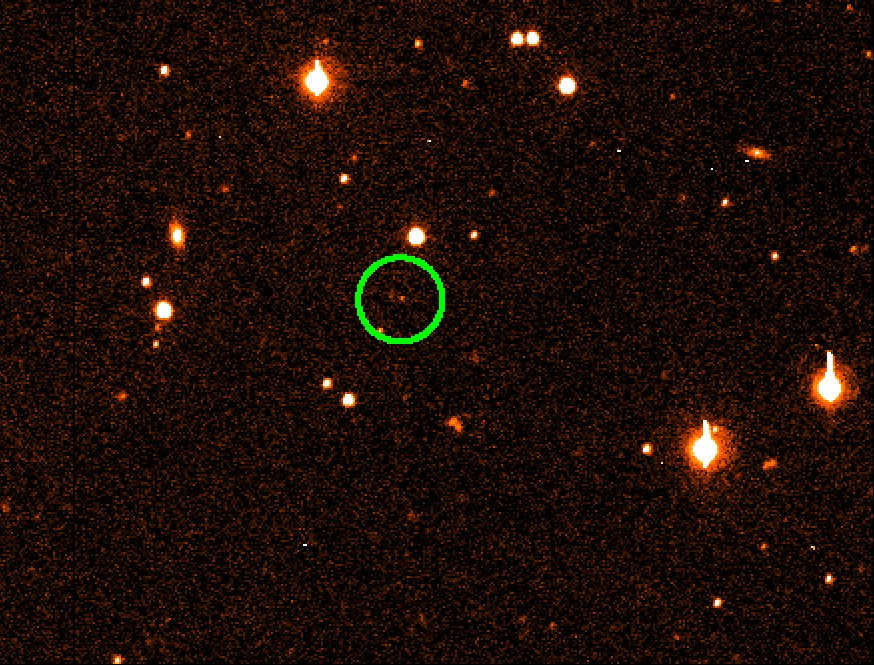
Sedna, celestial objects that are potential members of the inner Oort cloud.
It is believed that this vast cosmic cloud contains at least a billion “embryos” of future comets. These are bodies that freely orbit and have never come close to the Sun. Oort theorized that there are at least 10 to the 11th power of such bodies in the cloud. However, in addition to these, there are also billions of “established” comets, which have already had encounters with the Sun. It is worth noting that the orbits of these comets will later be influenced by their proximity to each other during their “embryo” stage, as well as the gravitational pull of neighboring stars and potentially existing bodies like planets and stars within the Oort cloud.
If we take a look at the Oort cloud, it becomes apparent that the cometary bodies within it have the ability to freely orbit around it for a considerable amount of time, they can escape the confines of the Solar System, and they can even make their way towards the Sun. In the latter scenario, we are presented with the opportunity to witness real comets complete with their characteristic tails. Modern scientific research has led us to believe that the cloud extends from the Sun at a distance of 2 light years. This fact also indicates that the orbit of the Oort cloud possesses a radius that is 3000 times greater than the radius of Pluto’s orbit. Furthermore, there have been reports suggesting that the combined mass of all the planets is less than the estimated mass of the cloud. This suggests that it is premature to discuss the final formation of the solar system and its long-term stability.
Research
Ongoing investigations are being conducted on the Kuiper Belt, as its entities could potentially be the remains of the initial accumulation stages of the solar system, predating all the planets. It is also hypothesized that short-period comets might originate from this region, analogous to how long-period comets are formed in the Oort cloud.
Detection and Discovery
Astronomer Frederick Leonard proposed the existence of objects beyond Neptune in 1930, challenging the notion that Pluto was the most distant object in the solar system. His hypothesis was later confirmed by Kenneth Edgeworth, who suggested that a nebula filled with small bodies existed at the edge of our system, preventing their assembly into a single planet.
Ironically, Gerard Kuiper, for whom the belt is named, argued against the existence of such a belt in 1951. At the time, Pluto was believed to be much larger than it actually is, leading Kuiper to speculate that any hypothetical belt would not have survived to the present day.

This theory has been in development for a considerable amount of time. Numerous astronomers and astrophysicists have dedicated their efforts to investigating and verifying the existence of this belt. Over time, the theory has gradually evolved into a well-supported hypothesis. In 1988, a groundbreaking research paper by Julio Fernandez provided the conclusive evidence needed to confirm the existence of a “comet belt” located beyond Neptune. Building upon Fernandez’s work, a group of scientists from Canada conducted calculations that further solidified the reality of this cluster. In his paper, Fernandez coined the term “Kuiper Belt,” a name that quickly gained popularity. The first visual evidence of objects within this belt was captured in 1992, and new discoveries continue to be made to this day.
Do this peculiar cloud possess any distinctive characteristics?

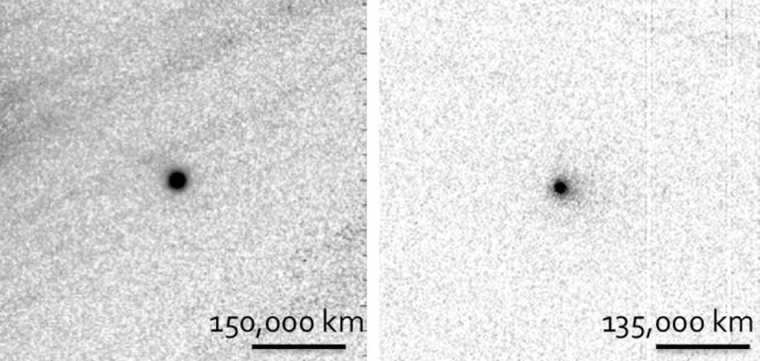
Images of objects detected in the Oort Cloud
There is a possibility that previous periods of comet bombardment have occurred. It was during these moments that the process of planet formation and development was intensified. It is estimated that, throughout the existence of our planet, alien stars have penetrated the inner region of the Oort Cloud about a dozen times, greatly increasing the movement of comets. This phenomenon lasts for approximately 400,000 years, during which an average of two hundred comets will collide with Earth, creating a significant cosmic event within the scientific community.
The future of the Kuiper belt
Kuiper’s hypothesis that there are no longer any objects beyond Neptune is not entirely accurate. While it is true that these objects will not last indefinitely, they are currently colliding with one another and gradually disintegrating into dust. However, in approximately one hundred million years, there will be no evidence remaining of the Kuiper belt.
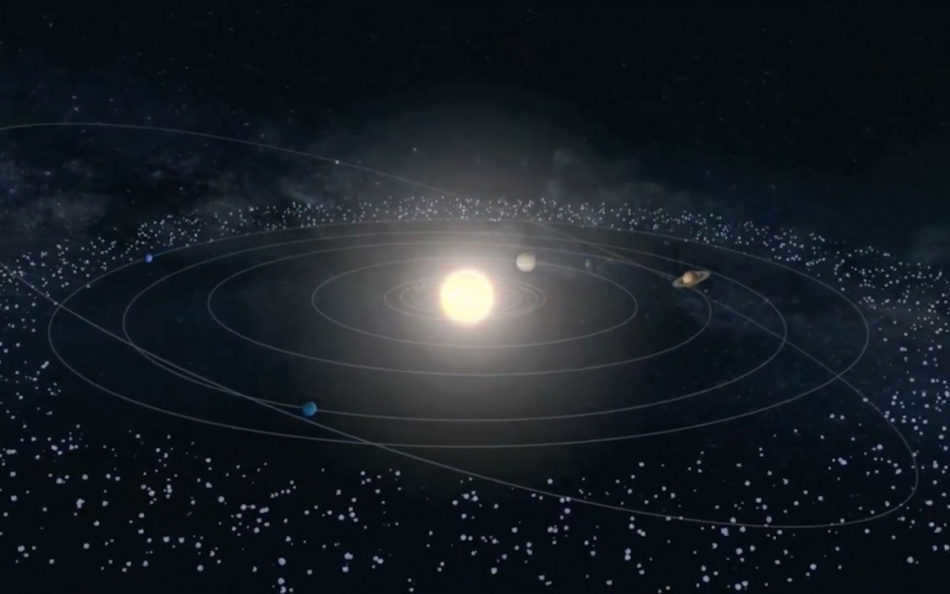
Curious details about the Kuiper belt
The most intriguing detail about the Kuiper belt is its donut-like shape. After that, there is no point in reading the rest of the details, but if you still desire to, here they are:
- It is the oldest entity in our system, originating during its formation.
- It could contain numerous distinct entities, ranging from small fragments to fully-fledged dwarf planets.
- Similar belts exist around other stars, like HD 138664.
- Its central region could accumulate up to a few trillion comets.
- No life exists there.
In 1932, the astronomer Erns Epic proposed that comets with long orbital periods originated from a vast cloud located outside our solar system. Around 1950, another astronomer named Jan Oort independently put forward the same theory, which created a paradox. Jan Oort argued that meteorites could not have formed in their current orbits due to the astronomical phenomena that govern them. Therefore, he suggested that all of the meteorite orbits must be contained within a massive cloud. This cloud was subsequently named after these two esteemed astronomers.
Oort examined two categories of comets. They included comets with orbits smaller than 10 astronomical units (a.u.) as well as long-period comets (which are nearly isotropic) with orbits larger than 1,000 a.u., some even extending up to 20,000 thousand a.u. Furthermore, Oort observed that these comets approached from various directions. This led him to infer that the hypothetical cloud from which they originated must possess a spherical configuration.
Why does the Oort Cloud exist and what does it encompass?
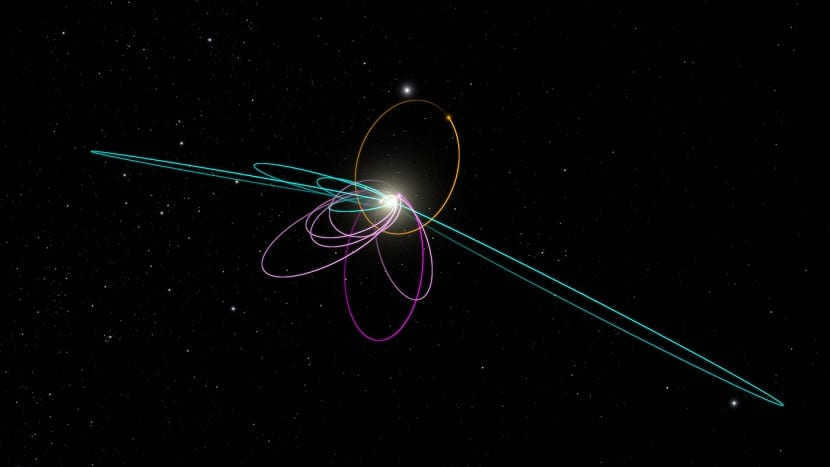

According to theories, the Oort Cloud originated during the formation of our solar system, as a result of large collisions and bombardment of materials. These objects were initially formed in close proximity to the Sun. However, the gravitational influence of the gas giant planets caused their orbits to become distorted, ultimately sending them to distant locations within the Oort Cloud.
Comet orbits, NASA modeling
The Oort Cloud can be divided into two distinct regions:
- The Outer Oort Cloud is a spherical region that is primarily influenced by other stars and the galactic tide, which alters the planetary orbits and makes them more circular. Its distance measures between 20,000 and 50,000 AU, serving as the outermost limit of the Sun’s gravitational pull.
- Outer Oort Cloud: Spherical in shape, more related to other stars and the galactic tide, which changes the orbits of planets, making them more circular. Measures from 20,000 50,000 to XNUMX XNUMX XNUMX AU… It should be added that this is really the limit of the Sun’s gravity.
The Oort Cloud encompasses all the planets in our solar system, as well as dwarf planets, meteorites, comets, and billions of celestial bodies with diameters exceeding 1.3 kilometers. Despite the large number of celestial bodies, there is a significant distance of tens of millions of kilometers between them. The total mass of the Oort Cloud is unknown, but by estimating the mass based on Halley’s Comet as a prototype, it is roughly calculated to be around 3 × 10^25 kg, approximately 5 times the mass of planet Earth.
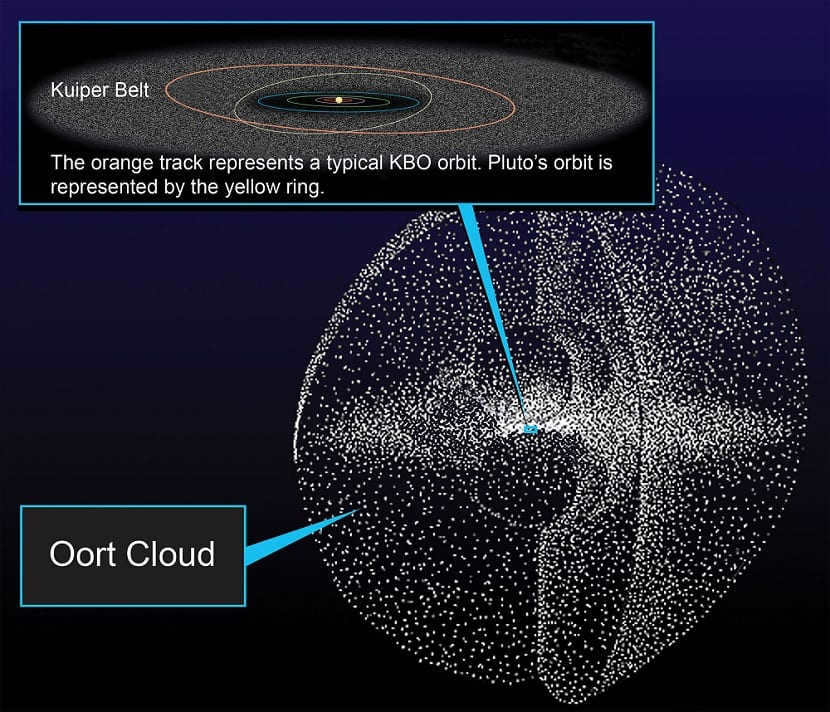
Located at the outer edges of the solar system.
Where does the boundary of our solar system lie? Half a century ago, scientists would have answered that it extends beyond the orbit of Pluto. Today, astronomers have expanded that understanding: they believe it stretches to the outer limits of the Sun’s gravitational influence, extending several light-years. As a result, our solar system is much larger than the orbits of the most distant planets. “It would take thousands of years for spacecraft to actually reach interstellar space.”
Once you move past Neptune’s orbit, you’ll find yourself in the vast expanse of the Kuiper belt. This region stretches from a distance of approximately 30 astronomical units (a. e.) from the Sun to a whopping 55 a. e. away. Within the Kuiper belt, you’ll come across celestial objects that are largely made up of frozen methane, water, and ammonia. Interestingly, this belt is also home to numerous dwarf planets that gracefully orbit through its vast reaches.
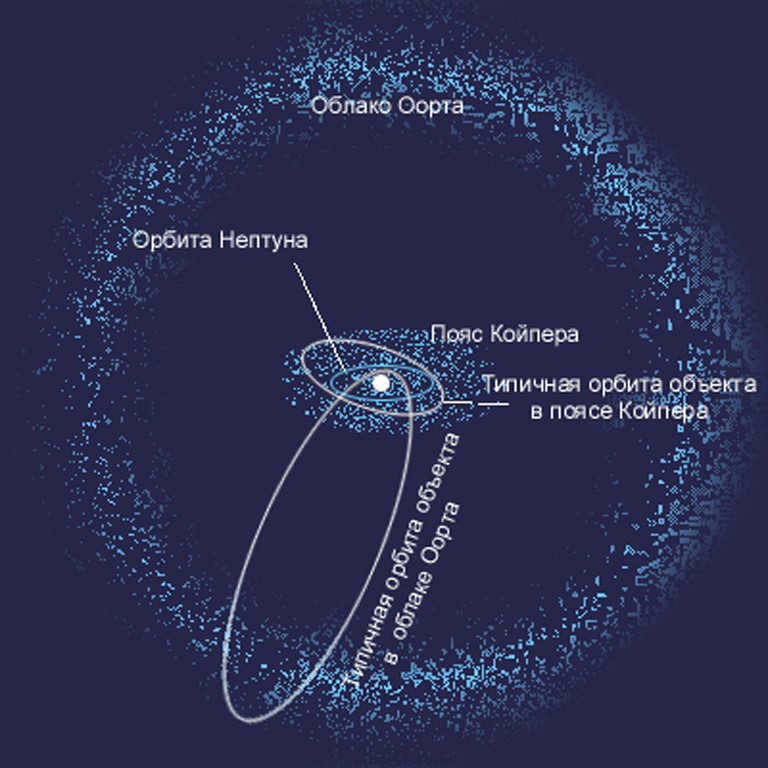
The Kuiper Belt and the Oort cloud are two clusters where comets originate from and have different orbital patterns. Short-period and long-period comets can be observed coming from these regions as they make their way into the inner solar system.
Located even further away is the Scattered Disk, which partially overlaps with the Kuiper Belt. This region is the primary source of short-period comets. A famous example is Halley’s Comet, which comes close to Earth approximately every 75 years. Extending beyond the Kuiper Belt is the Oort cloud, whose outer edge is defined by the Hill sphere.
Structure and composition
The Oort cloud is an enormous spherical swarm of comets, consisting of billions of objects. It is located at the outer boundary of the solar system, with its inner boundary approximately 2-5 thousand astronomical units (a.e.) away from the Sun, and its outer boundary about 50 thousand a.e. away. The cloud is considered to be one of the main sources of periodic comets in our system, along with the Kuiper belt.
Trillions of comet nuclei are believed to reside within the Oort cloud, and under certain conditions, they can venture into the inner regions of the solar system. These objects can peacefully drift within the cluster for millions of years, until they are influenced by gravitational interactions.
Although the exact mass of the Oort cloud is uncertain, it is undoubtedly many times greater than the mass of our planet.
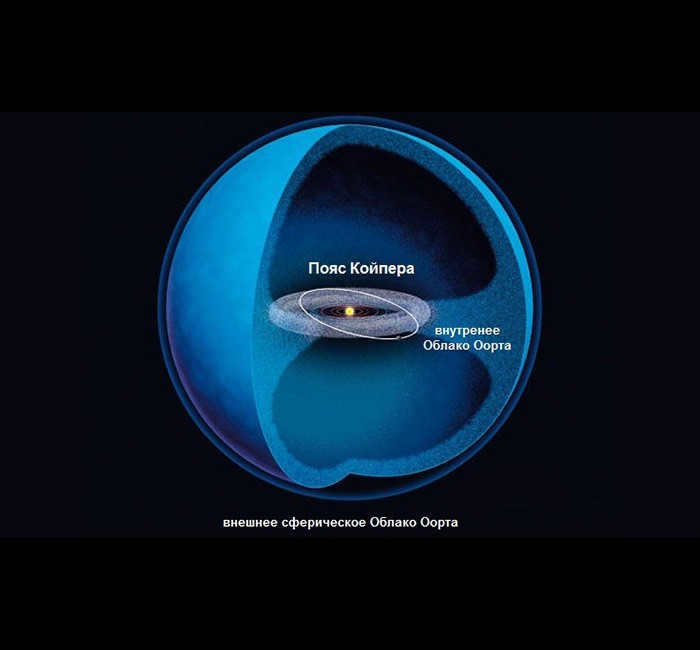
The Oort cloud is composed of two main parts: a disk-shaped interior known as the Hills cloud and a spherical exterior.
Based on available data, it is believed that the objects in the Oort cloud are primarily composed of methane, water, cyanide compounds, and carbon dioxide. However, the discovery of asteroid 1996 PW suggests the presence of rocky objects in the cluster, which may be fragments of disintegrated planetoids.
The structure and properties of the Oort Cloud vary at different distances from the Sun.
It can be divided into two main regions:
- The inner region, known as the Hills cloud, which has a disk-like shape;
- Bodies in the solar system, such as asteroids, comets, and meteorites, have orbits that are located within the plane of the ecliptic.
- The objects found in the Hills cloud also possess orbits that are relatively circular and stable. However, in the outer region, these bodies move in a chaotic manner and in various planes. This is due to the gravitational influence not only from the Sun but also from other stars.
- The inner portion of the Hills cloud is the most densely populated, containing approximately one-sixth of all the objects in the cluster.
The Sun’s gravitational force is not strong enough at that distance, however, external factors have a significant impact on comets and planetoids from the cloud. The gravitational force from nearby stars and the tidal forces from our Milky Way galaxy have caused the orbits of the cluster’s comets to change. This hypothesis could account for the nearly perfect spherical shape of the cloud. It is possible that in the far future, the Hills cloud will also adopt a spherical form.
The Oort Cloud sets the limits of the Solar System
It is believed that the outer boundary of the Oort Cloud marks the borders of the Solar System and establishes the extent of the Hill sphere for the Sun. To put it simply, the Hill sphere limit for the Sun, named after the American astronomer George William Hill, who first defined it, signifies the point at which the Sun’s gravitational pull ceases to dominate in the presence of the gravitational influences of larger celestial bodies. In this scenario, those bodies could either be the Milky Way galaxy or star clusters that come within a relatively close distance of the Hill sphere limit for the Sun.
Origin of the Oort cloud
Scientists now have a strong belief that the Oort cloud originated from a gas-dust nebula, which eventually gave rise to the planets and other celestial bodies in our solar system. This event took place approximately 4.5 billion years ago. Initially, the objects within the cluster were situated in much closer proximity to the Sun, but the immense gravitational force exerted by the giant planets caused them to be “ejected” into their current distant orbits.
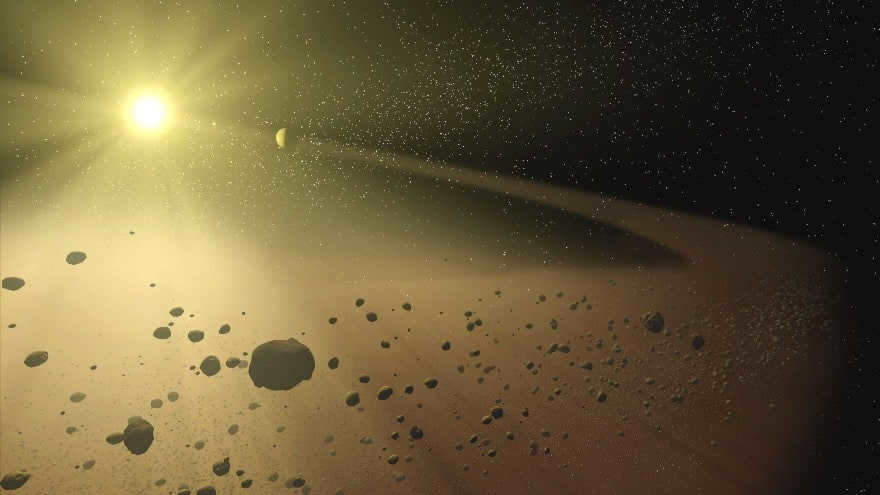
The Oort Cloud is a collection of numerous icy and rocky objects
The aggregate achieved its peak mass roughly 800 million years after its formation. As per certain models, one of the primary “suppliers” of materials for it was a scattered disk. The existence of this collection aligns perfectly with the theory of our system’s formation as part of a unified stellar collection consisting of 200-400 stars. These stars likely played a significant role in the establishment of the Oort cloud: at that time, stars approached the Solar System much more frequently than they do today.
It is uncertain whether such clusters are representative of our Universe, but they have already been detected in other stellar systems. Further investigations are ongoing. Perhaps in the near future, we will obtain an answer to this inquiry.
Discovery Background of the Oort Cloud
The initial speculation regarding the presence of a vast region at the outer reaches of the solar system, where comets originate from, was made by astronomer Ernst Epick in 1932. In 1950, a similar concept was proposed by Dutch astrophysicist Jan Oort. He was focused on resolving the dilemma of short-lived comets, which rapidly disintegrate due to solar radiation or are destroyed in collisions with larger celestial bodies.
The scientist put forward the idea that there is a “vast supply” of cometary bodies somewhere on the outskirts of our solar system, enough to compensate for their natural depletion. The scientific community was highly skeptical of this theory.
After analyzing nineteen different comets, Oort concluded that all of them are “native” inhabitants of our solar system and originate from a region located 20 thousand astronomical units away. He observed that the velocity of these objects was 1 km/s, while the nearest stars move relative to the Sun at a speed of approximately 20 km/s.
Oort hypothesized that this region contains around 1011 cometary “embryos”, a significant portion of which never come close to the Sun.
Origin
The formation of the solar system is believed to have left behind a cloud which now exists as the remnants of the protoplanetary disk, from which the planets eventually formed.
According to the widely accepted theory, the objects within this cloud were scattered from the inner regions near the Sun to the outer regions by the gravitational pull of the giant planets.
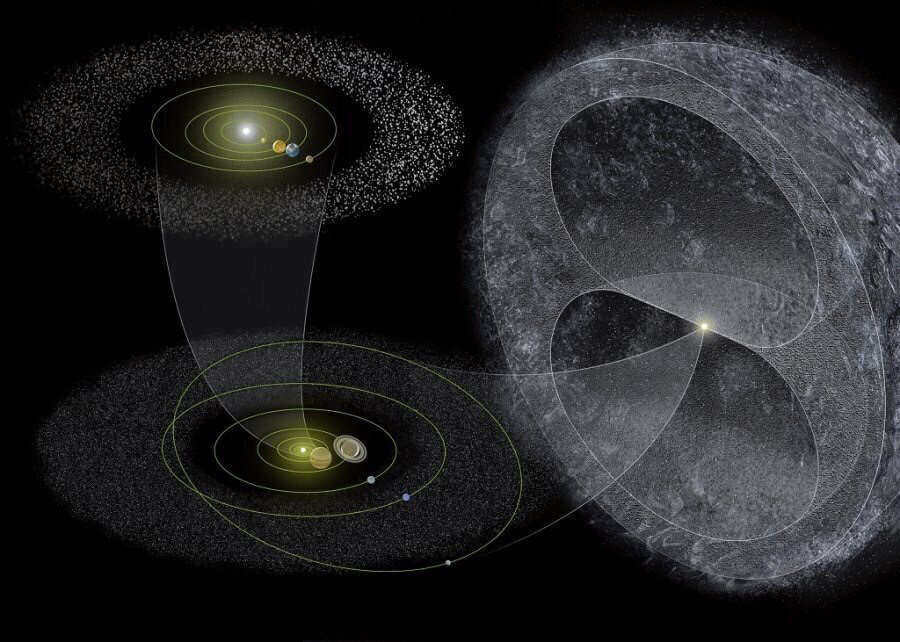
Orbits of celestial bodies in the solar system
Objects in the Oort cloud
Sedna is a potential dwarf planet. The characteristics of its orbit suggest that it may belong to the Oort cloud. In addition to Sedna, there are at least four other objects that call the Oort cloud their “home”.
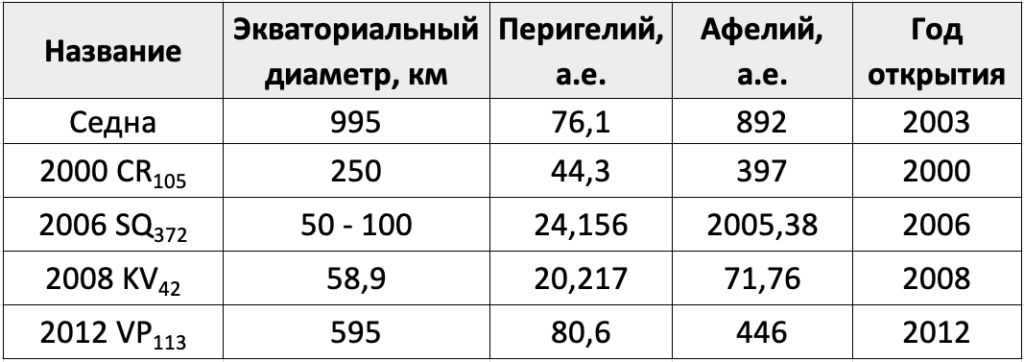
Picture Sedna – indicated by a green circle
Oort Cloud – the abode of comets with long orbits
Despite the fact that the question of the genesis (or even presence) of the Oort Cloud remains unresolved, ingenious astronomers have utilized information on the paths of observed comets with long orbits like Halley’s Comet as the foundation for the concept that all comets with long orbits, along with the Centaurs and Jupiter’s Family Comets, originate in the Oort Cloud.
It is believed that most comets with short orbits come from the scattered disk (which is not part of the Oort Cloud), but the possibility exists that their original birthplace was the outer regions of the Oort Cloud.
Even though scientists have not been able to directly observe the Oort cloud, they believe it takes the form of a spherical shape. The inner region of the Oort cloud is estimated to start at a distance of 2,000-5,000 a.u. (0.03-0.08 light-years) from the Sun and extends about 100,000-200,000 a.u. (1.58-3.16 light-years) from the Sun. This is quite significant when considering that Proxima Centauri, the closest star to our solar system, is only 4.2 light-years away from Earth.
The Oort Cloud has a mass that is only five times greater than that of Earth.
By utilizing advanced computer simulations, scientists have determined that the Oort Cloud is home to an estimated few trillion objects that have a diameter larger than one kilometer, as well as several billion objects with diameters around 20 kilometers. Remarkably, these objects are, on average, separated by tens of millions of kilometers. Although the exact mass of the Oort Cloud remains uncertain, calculations based on the mass of Halley’s Comet, which is believed to originate from the Oort Cloud, suggest that the total mass of the objects in the Oort Cloud is approximately 3 x 10^25 kilograms, equivalent to five times the mass of our planet.
Tidal Impact in the Oort Cloud and on Earth
Similar to the way the Moon influences the oceans by causing tides, it has been observed that this phenomenon occurs on a galactic scale as well. The gravitational force between celestial bodies diminishes as the distance between them increases. To comprehend this phenomenon, let’s examine the gravitational pull exerted by the Moon and the Sun on Earth. Depending on the Moon’s position relative to the Sun and our planet, the magnitude of tides can vary. The alignment with the Sun directly affects the gravitational force on our planet, which accounts for the significant rise in tides.
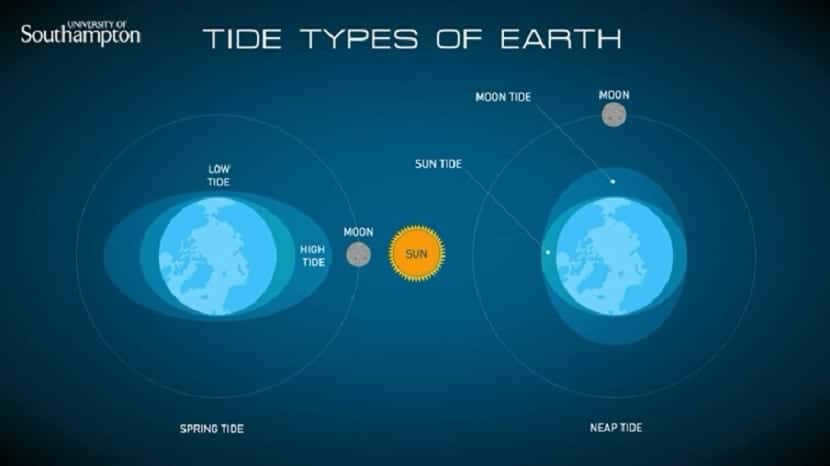
Imagine the Oort Cloud as the vast oceans of our planet, and the Milky Way as the Moon. This creates a tidal effect, causing a distortion towards the center of our galaxy. As we move away from the Sun, its gravitational force weakens, but even this small force can disrupt the movement of celestial bodies, redirecting them towards the Sun.
The patterns of species extinction on our planet
Researchers have been able to confirm the following: approximately every 26 million years, a recurring pattern emerges. This pattern involves the extinction of a significant number of species during these periods. Although the exact cause of this phenomenon remains uncertain, one hypothesis worth considering is the tidal effect of the Milky Way on the Oort cloud.
If we take into account the Sun’s orbit around the galaxy and its tendency to pass through the “galactic plane” with regularity, we can describe these cycles of extinction.
Scientists have determined that approximately every 20-25 million years, the Sun crosses the galactic plane. During this celestial event, the immense gravitational force exerted by the galactic plane has the potential to cause significant disruption to the Oort Cloud. The bodies within the Cloud will experience intense shaking and disturbance, resulting in many of them being ejected back towards the Sun.
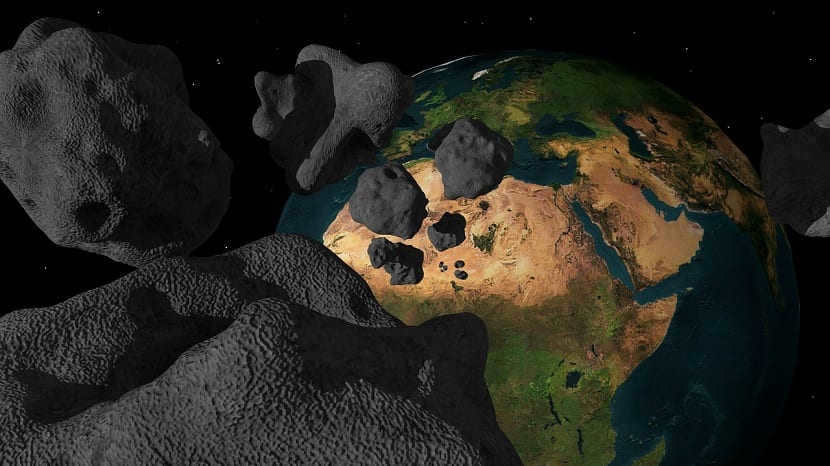
Comets originating from the Oort Cloud
It is thought that these entities peacefully meander within the Oort Cloud until they deviate from their typical trajectory as a result of a gravitational disturbance. This is the process by which they transform into long-period comets and venture into the outer solar system.
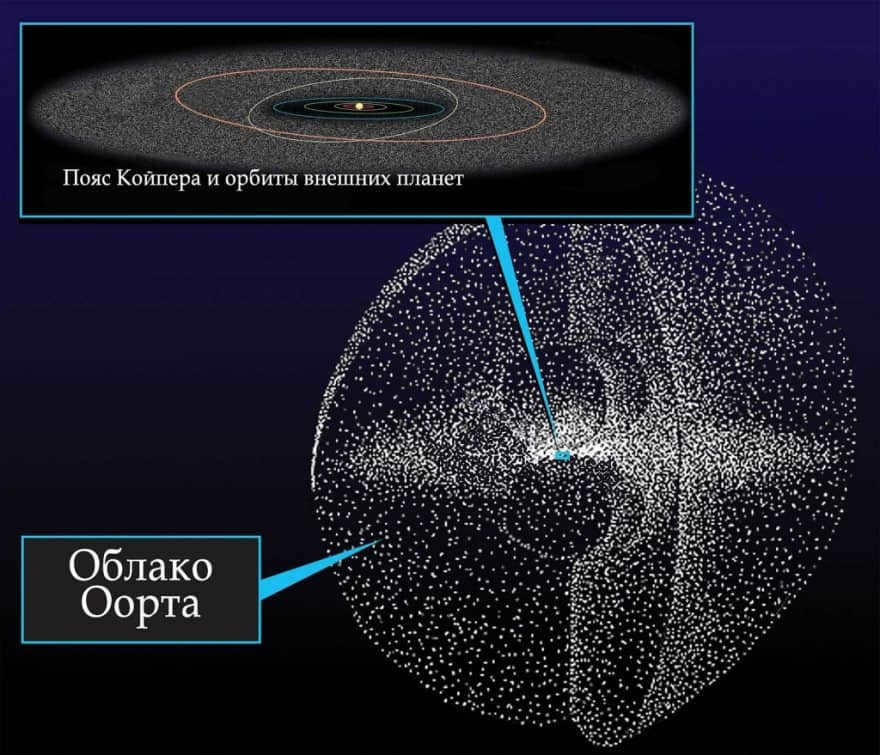
A comparison of the Oort cloud’s size and the Kuiper Belt.
The orbit of comets with short periods covers a few hundred years, while comets with long periods can stretch for tens of thousands of years. The former originate from the Kuiper Belt, while the latter are visitors from the Oort Cloud. However, there are exceptions.
Among these exceptions are the comets of Jupiter and Halley. Although the latter have a short period, they actually come from the Oort Cloud. In the past, they had a longer period but were influenced by the gravitational pull of a gas giant.
Objects beyond Neptune
Trans-Neptunian objects are a classification for all celestial bodies located beyond Neptune, whether they reside in the Kuiper Belt or the Oort Cloud. The Oort Cloud, being much farther away than the Kuiper Belt, poses significant challenges for observation and study. Astronomers have yet to identify objects within the Oort Cloud with the same level of detail as those in the Kuiper Belt, except for long-period comets. Only four celestial bodies have been discovered that may have originated in the Oort Cloud based on their orbits. Unfortunately, direct observations of this region will not be possible in the near future, and it may take several decades before any spacecraft can be sent to explore this part of the solar system.
The Voyagers have no chance either. It will require them another 300 years to reach their destination. Moreover, astronomers predict that it will take around 30,000 years to traverse the Oort cloud…..
What Lies Ahead for the Kuiper Belt
What is the size of the Oort Cloud?
The Oort Cloud is believed to be a vast collection of objects that orbit the Sun, located far beyond the furthest known planets. While it is difficult to measure the exact mass of the Oort Cloud, scientists estimate that it could be incredibly massive. One way to gauge its size is by looking at comets like Halley’s Comet, which is thought to have originated from the Oort Cloud. If we consider Halley’s Comet to be a representative example of objects in the outer region of the Oort Cloud, then we can extrapolate that the cloud itself may have a mass of approximately 3 x 10^25 kg – roughly five times the mass of the Earth. However, it’s important to note that this estimate is based on the assumption that Halley’s Comet is a typical object found in the Oort Cloud, which is not yet confirmed.
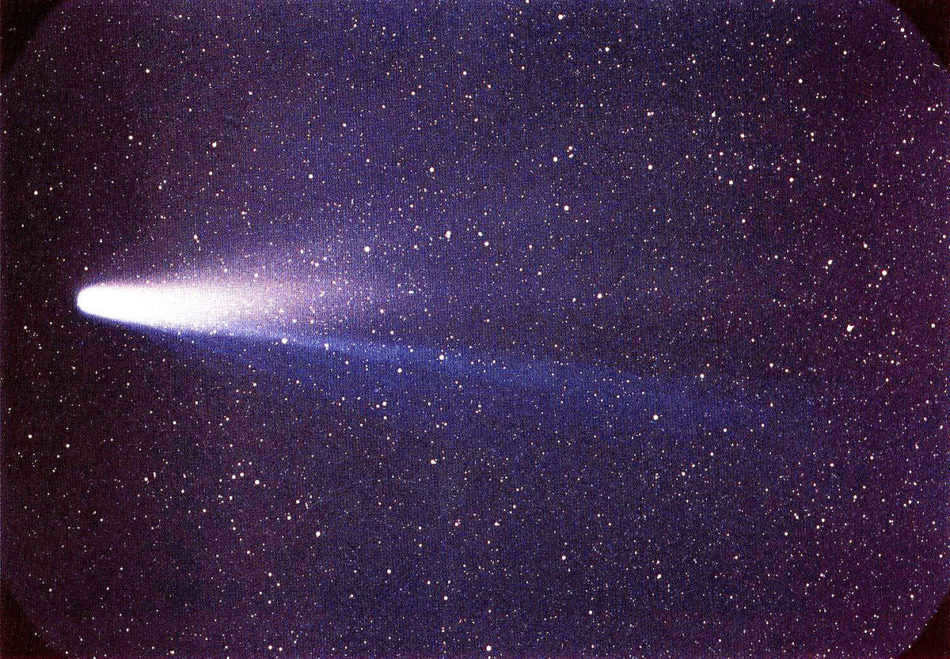
Upon examination of recent comet samples, scientists have determined that the majority of objects in the Oort Cloud are primarily composed of volatile compounds. These compounds include water, methane, ethane, carbon monoxide, hydrocyanic acid, and ammonia. Additionally, there have been sightings of asteroids in space that could potentially originate from this region as well. It is estimated that asteroids make up approximately 1 or 2% of the total objects within the cloud.





